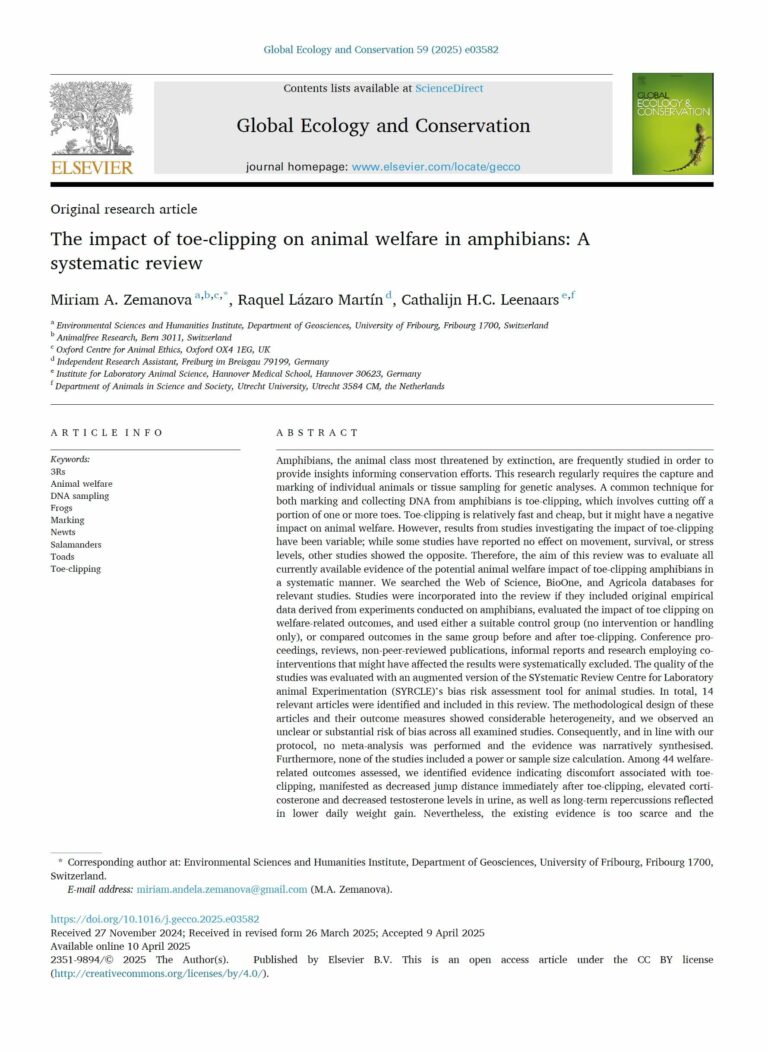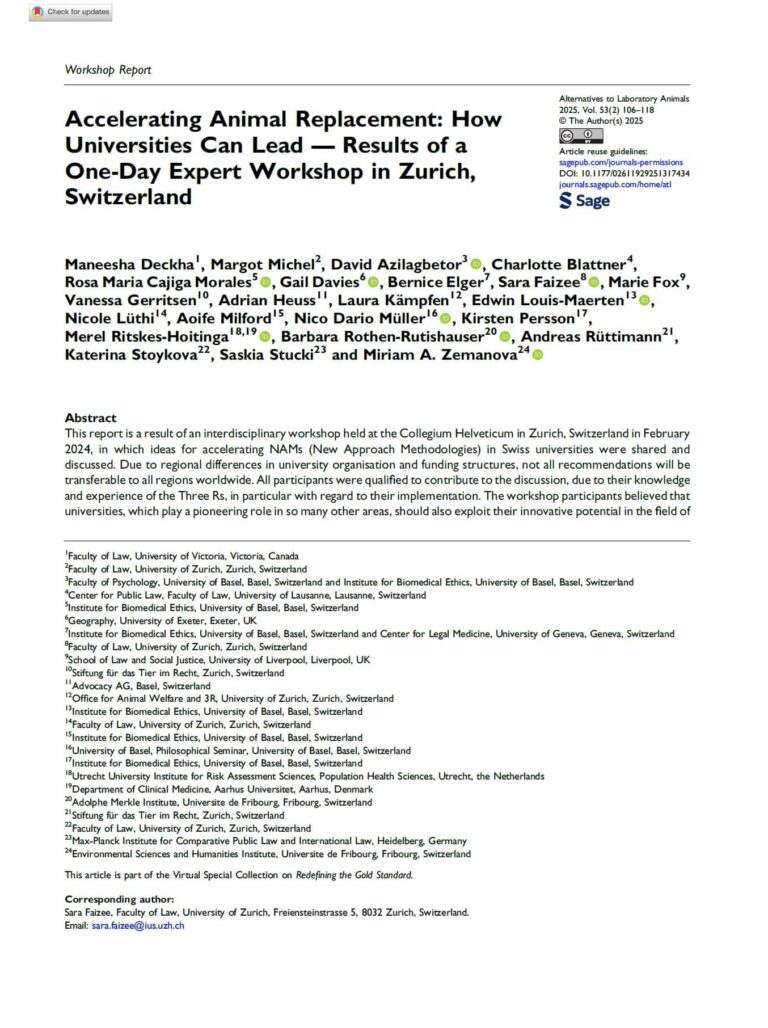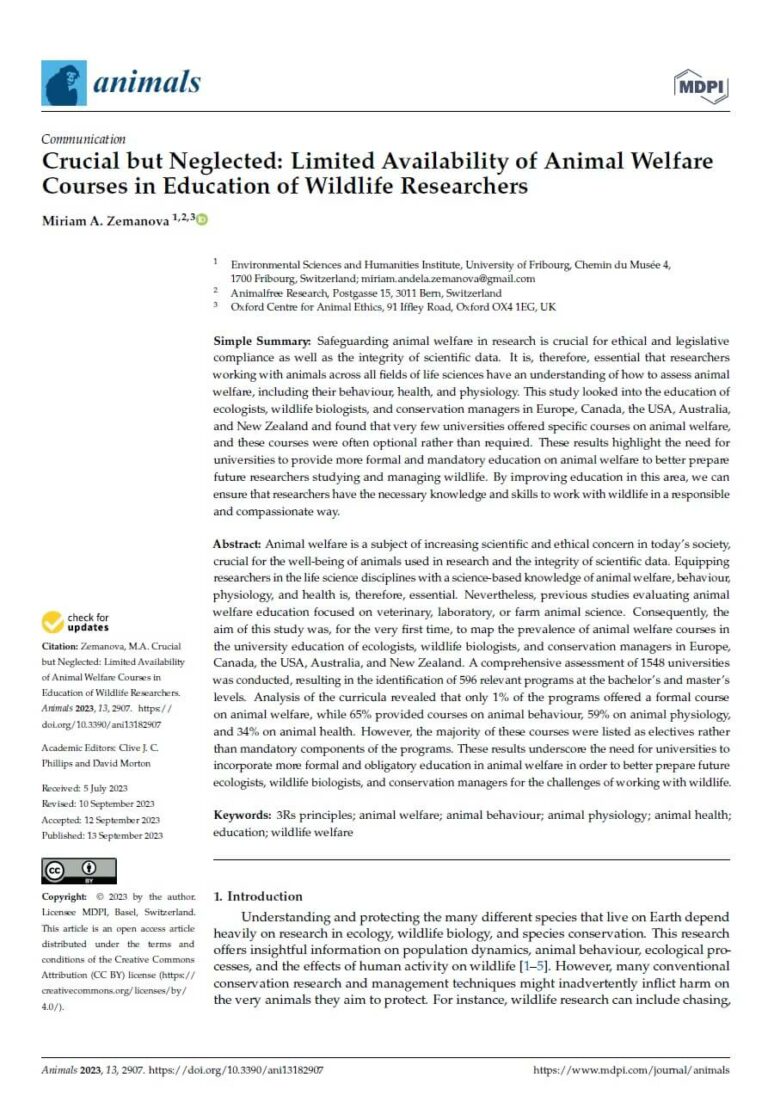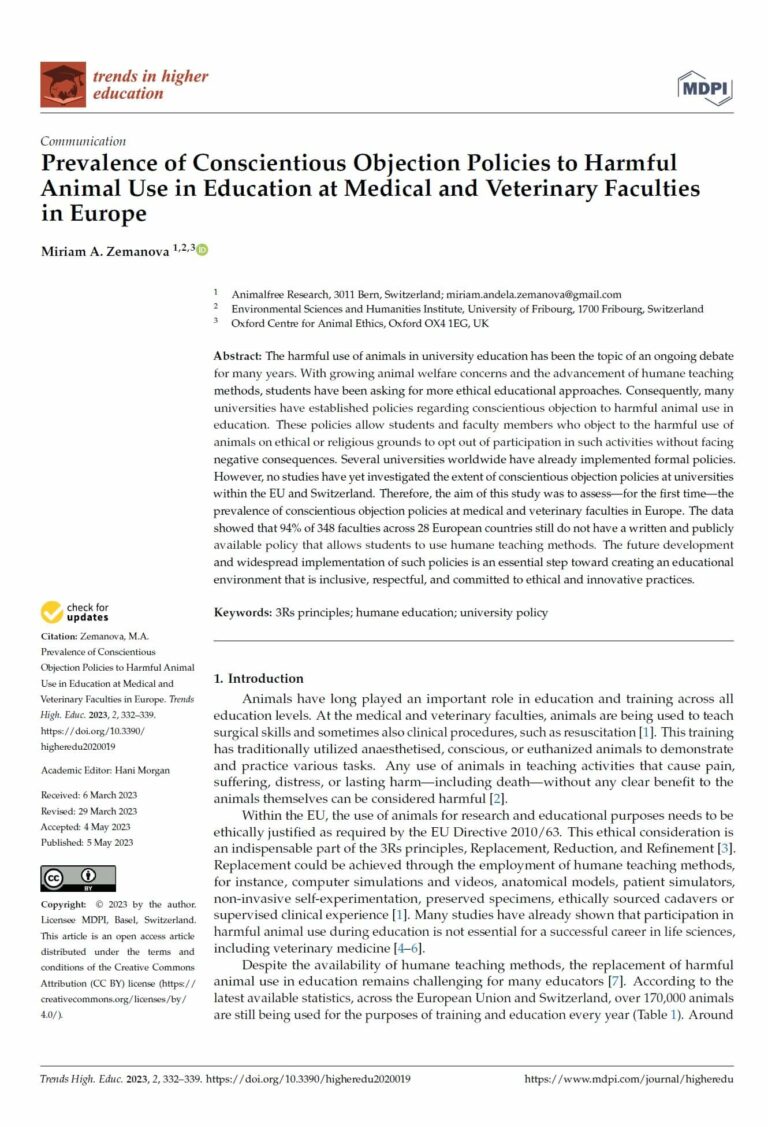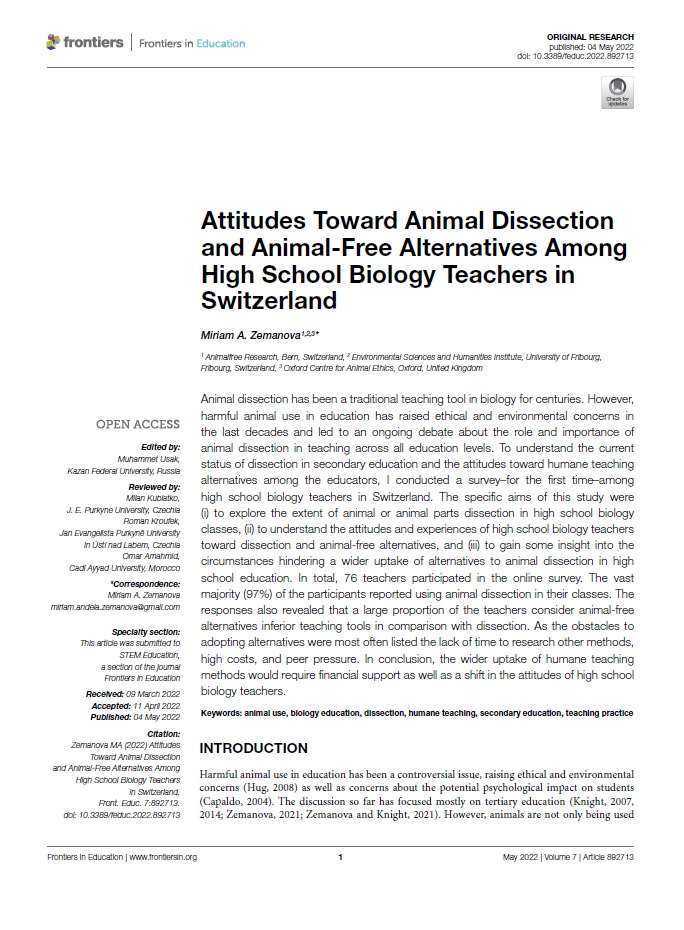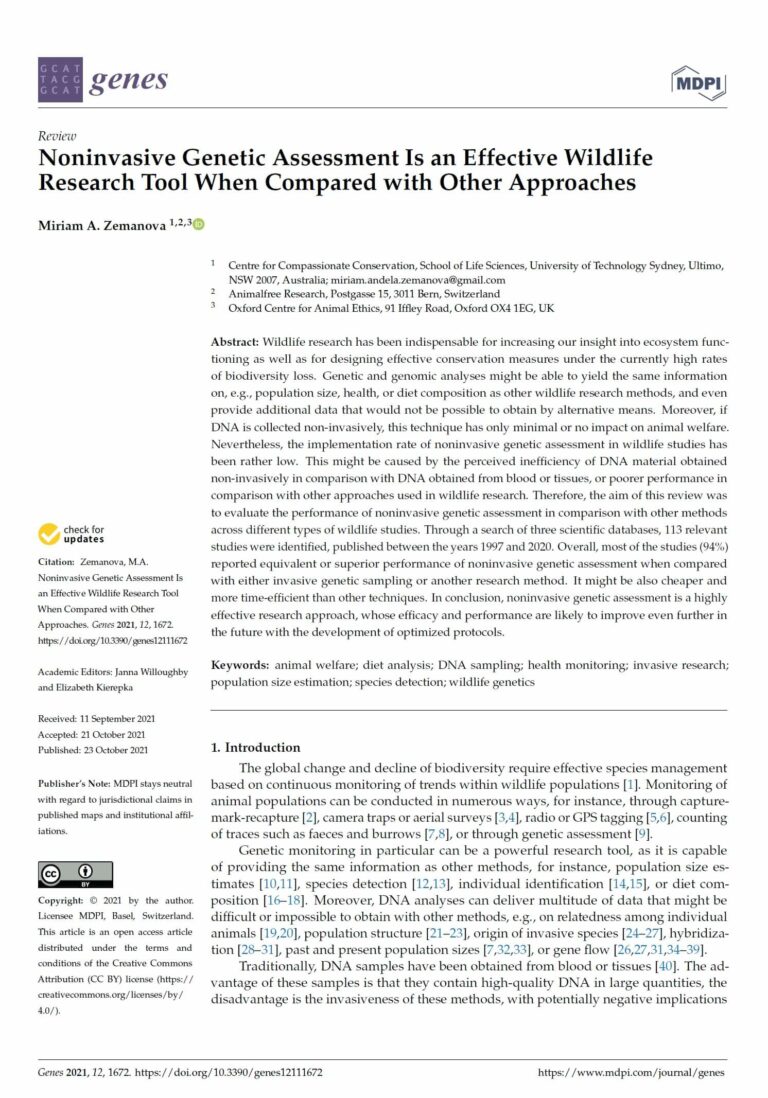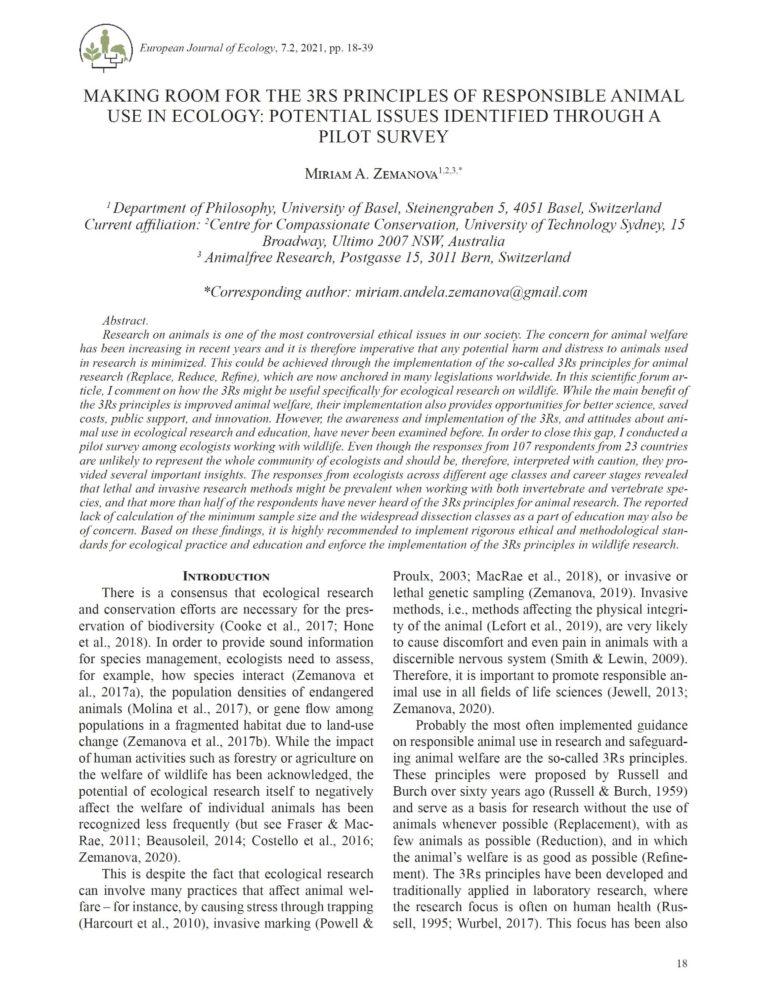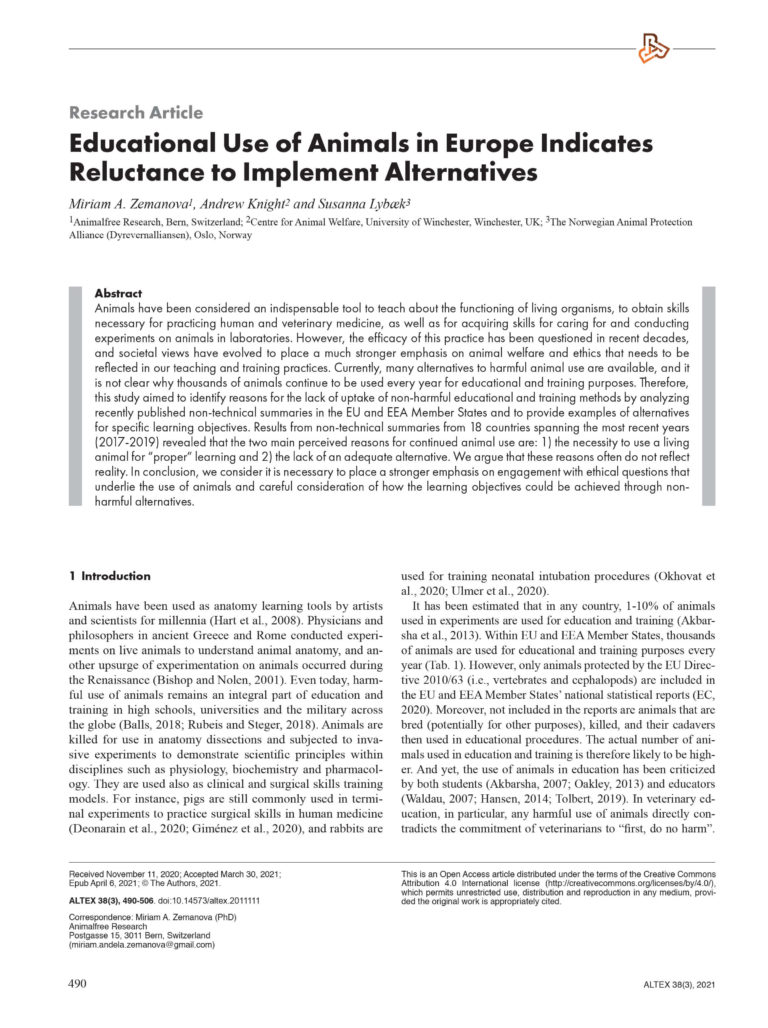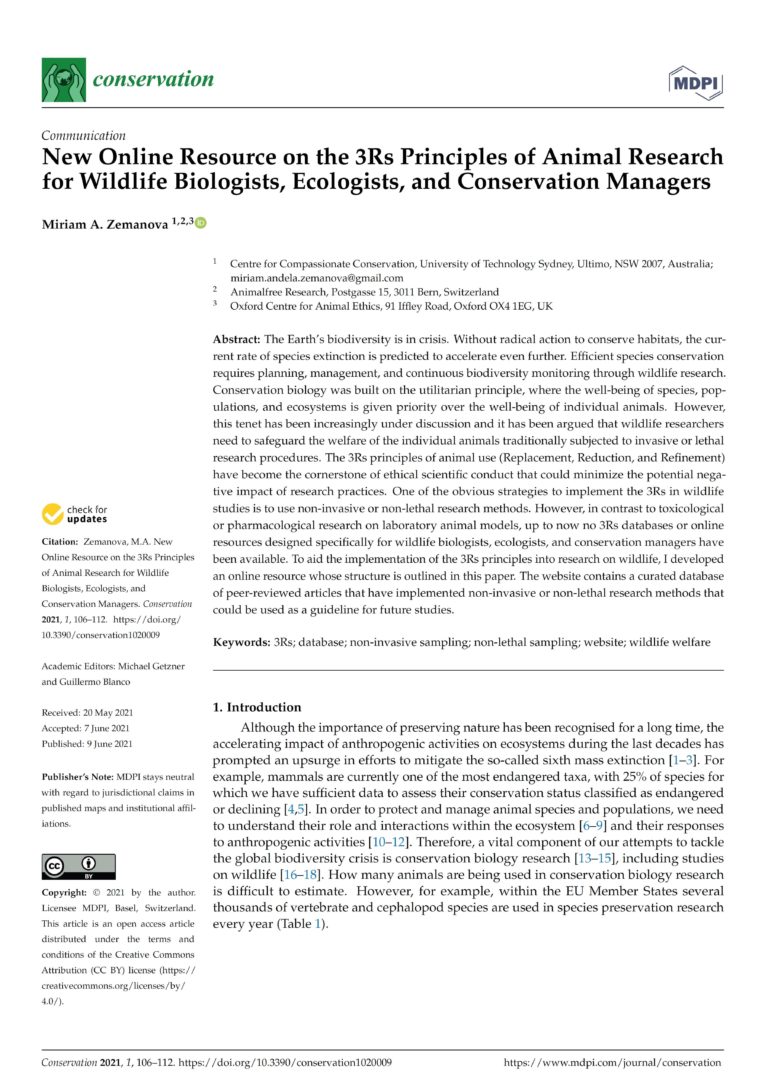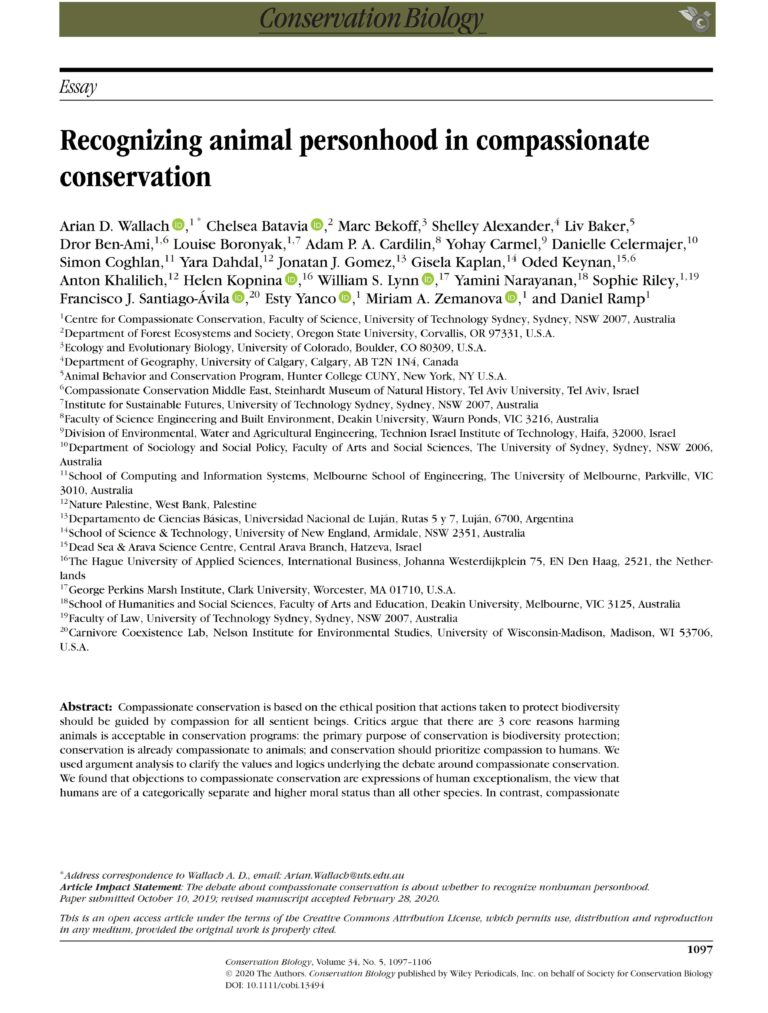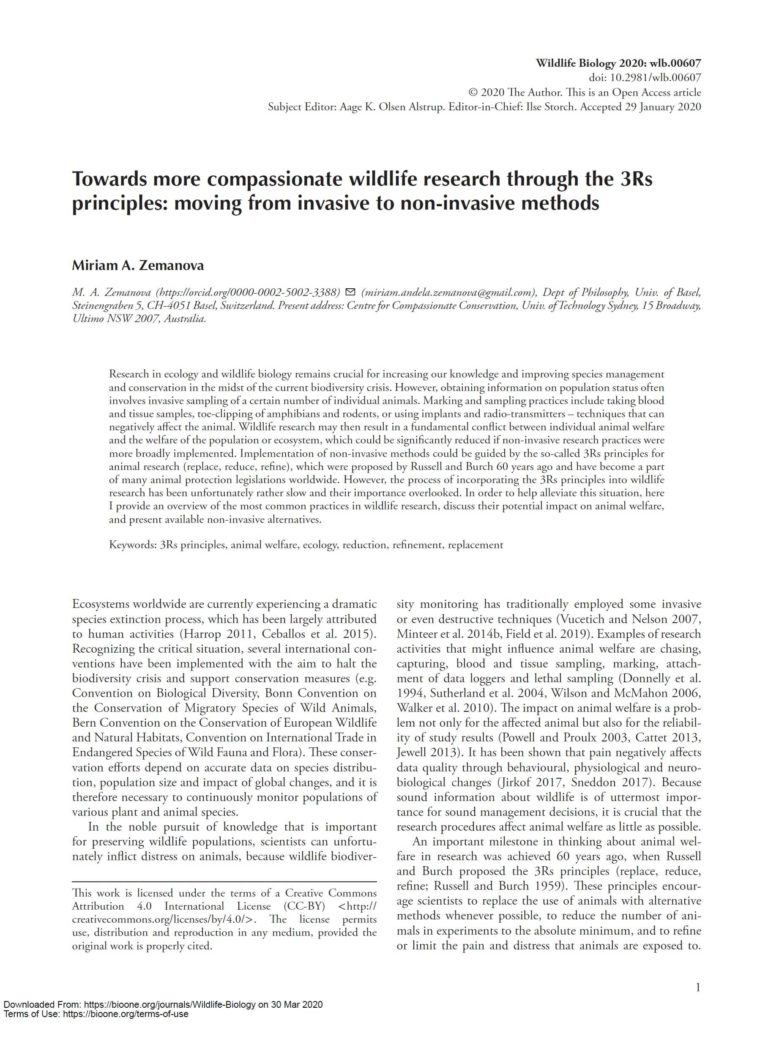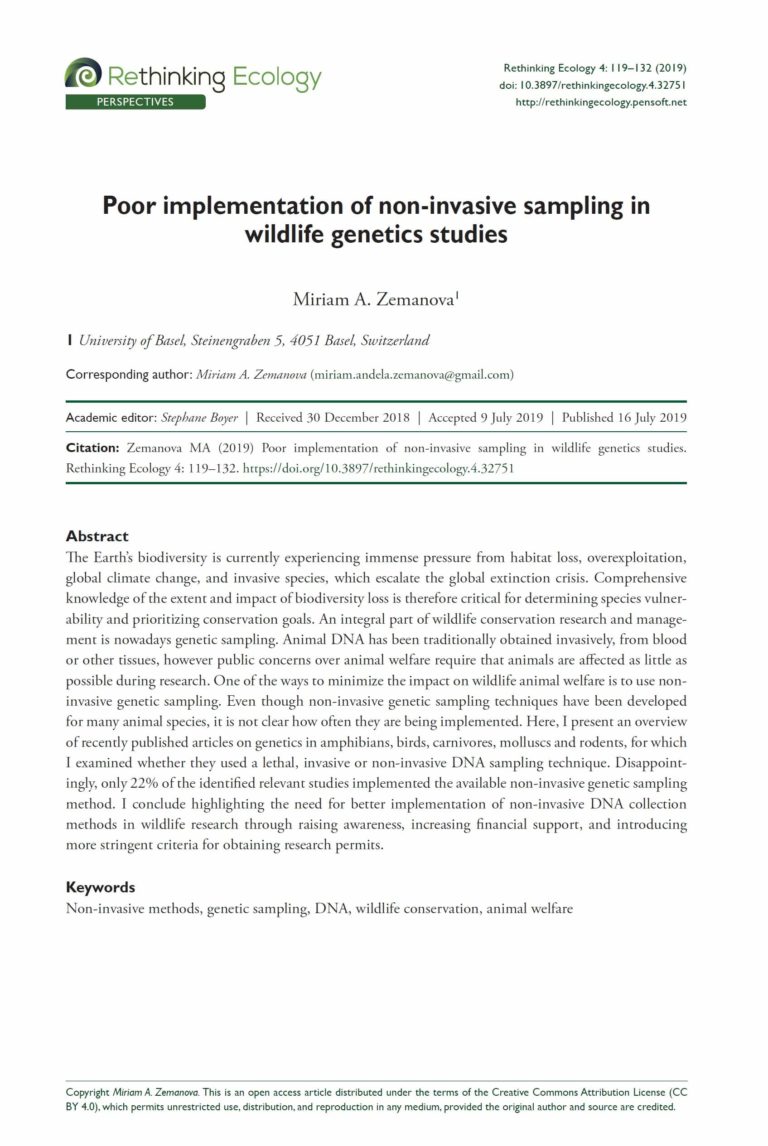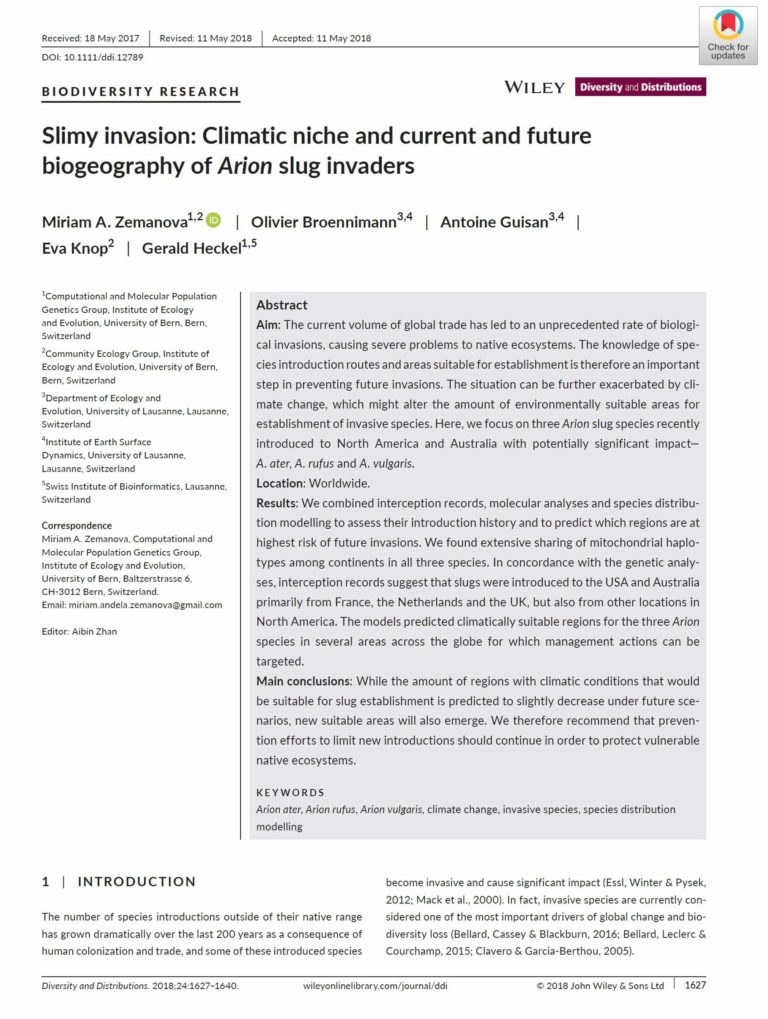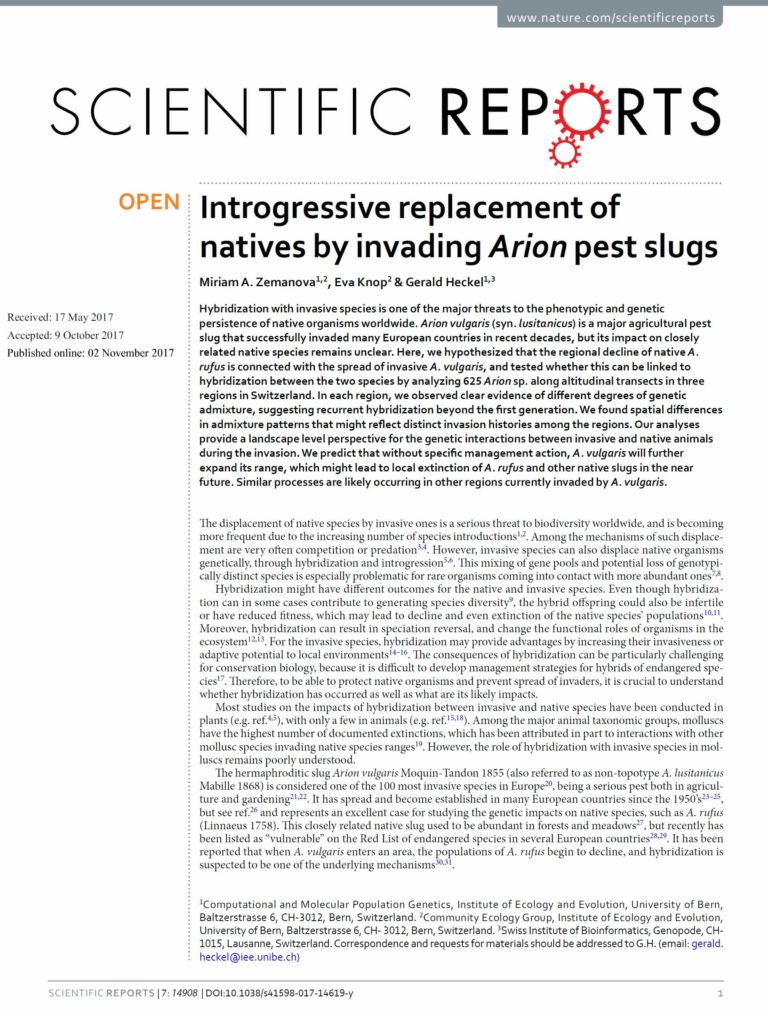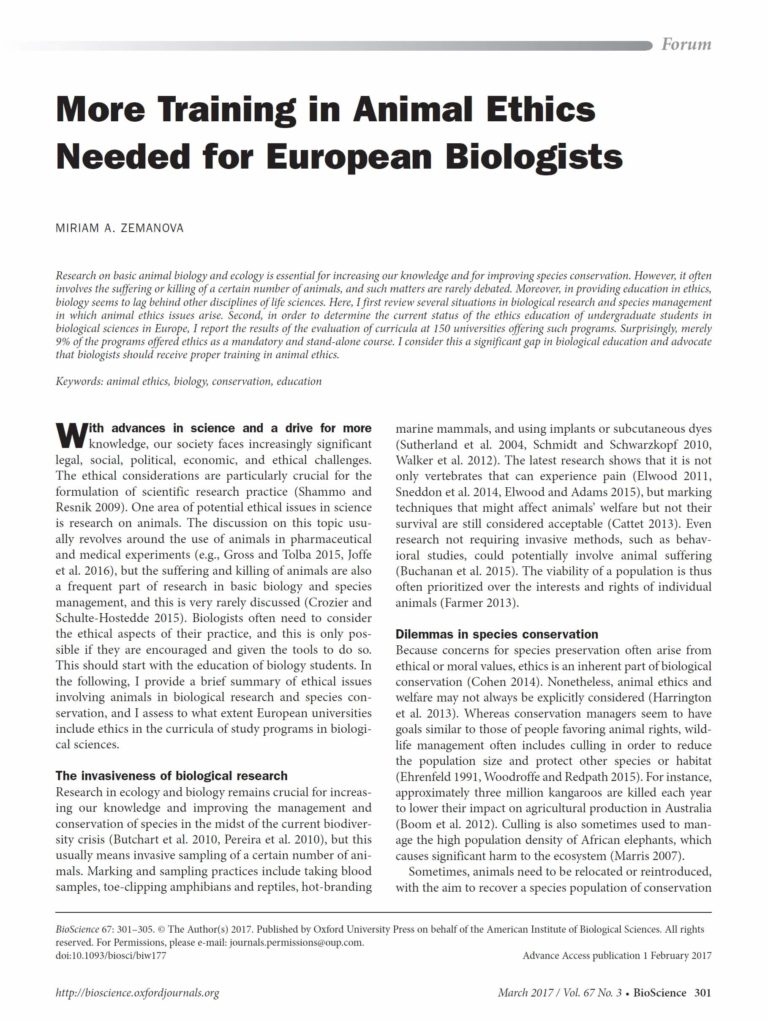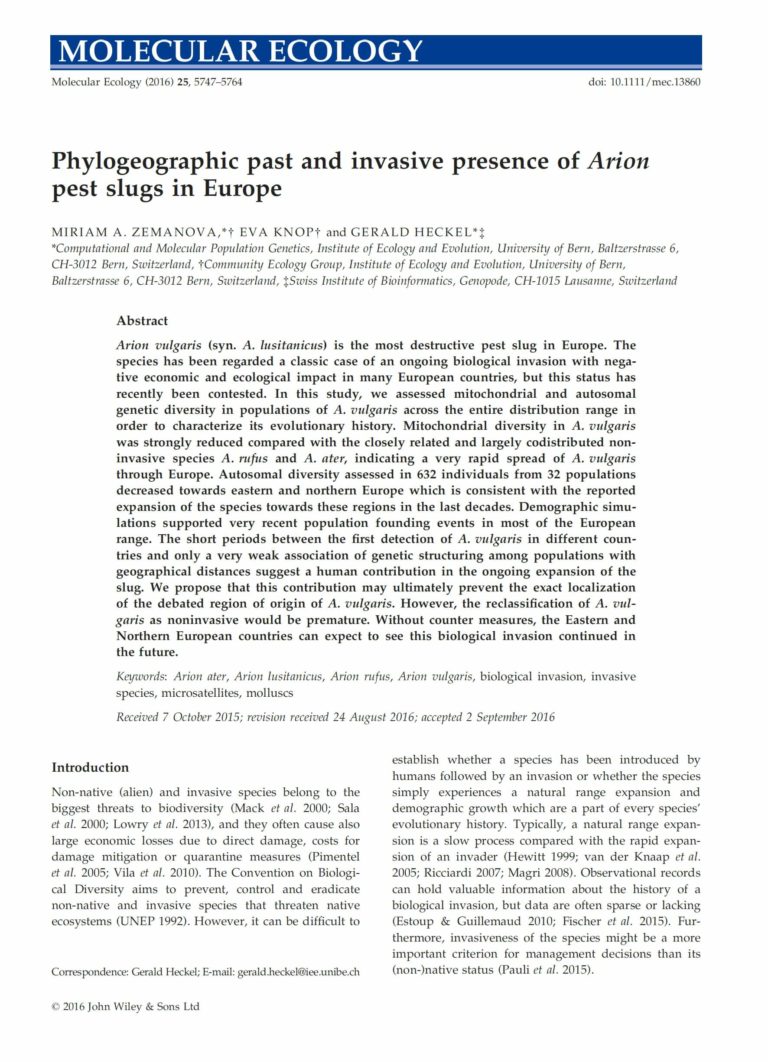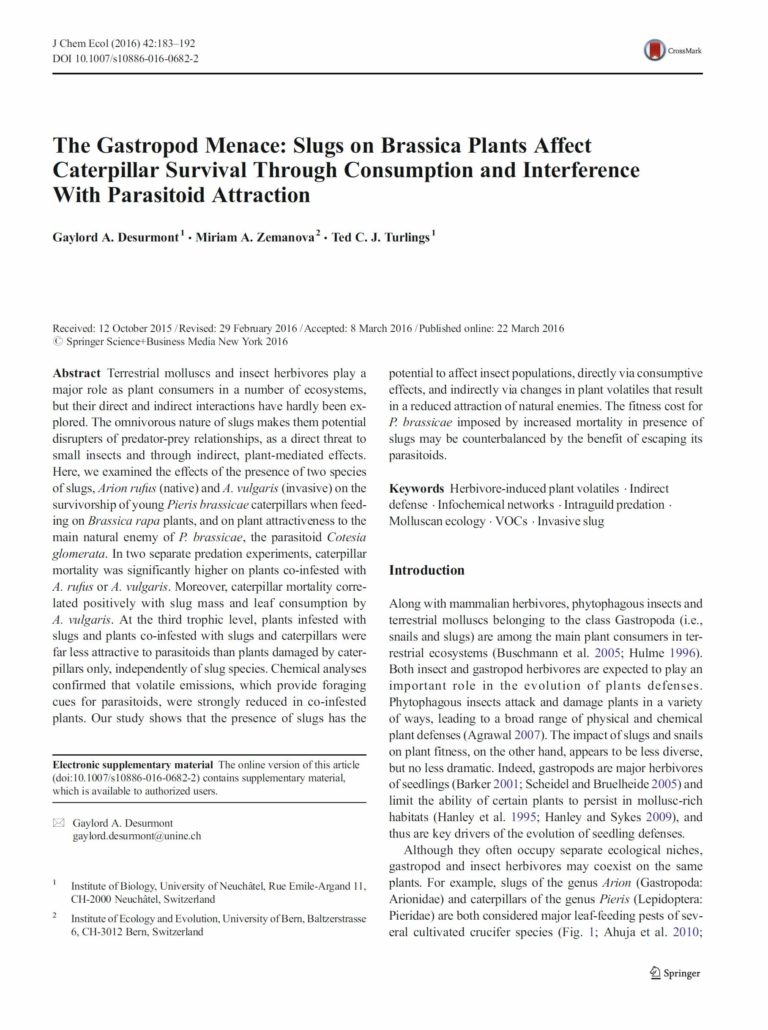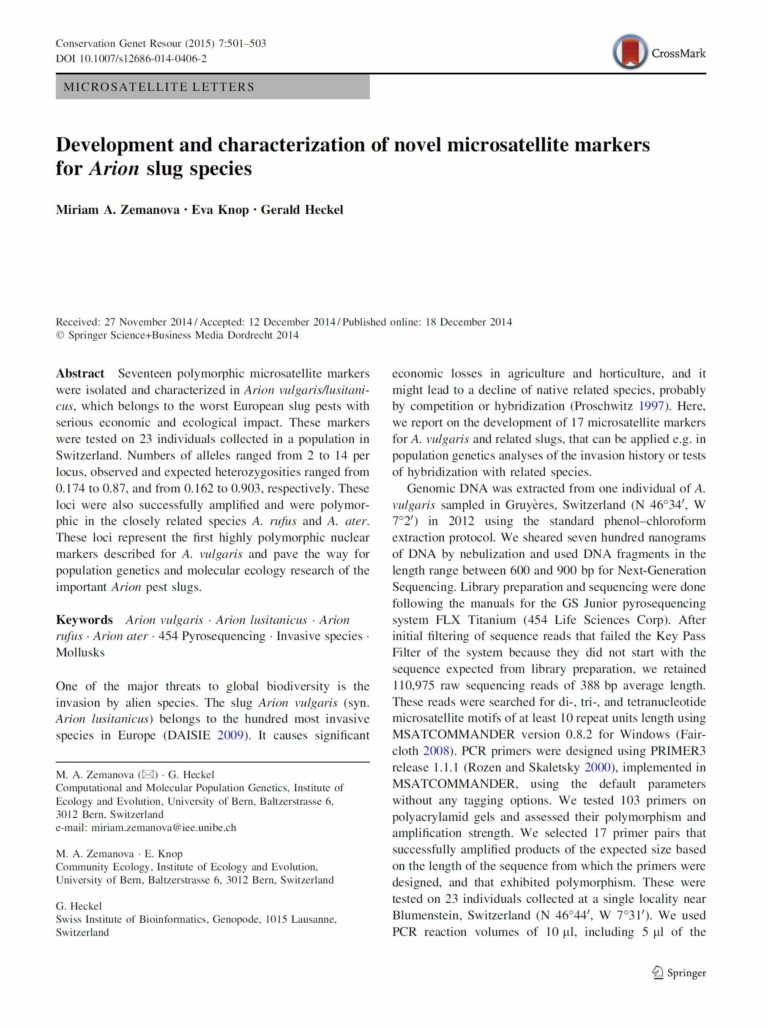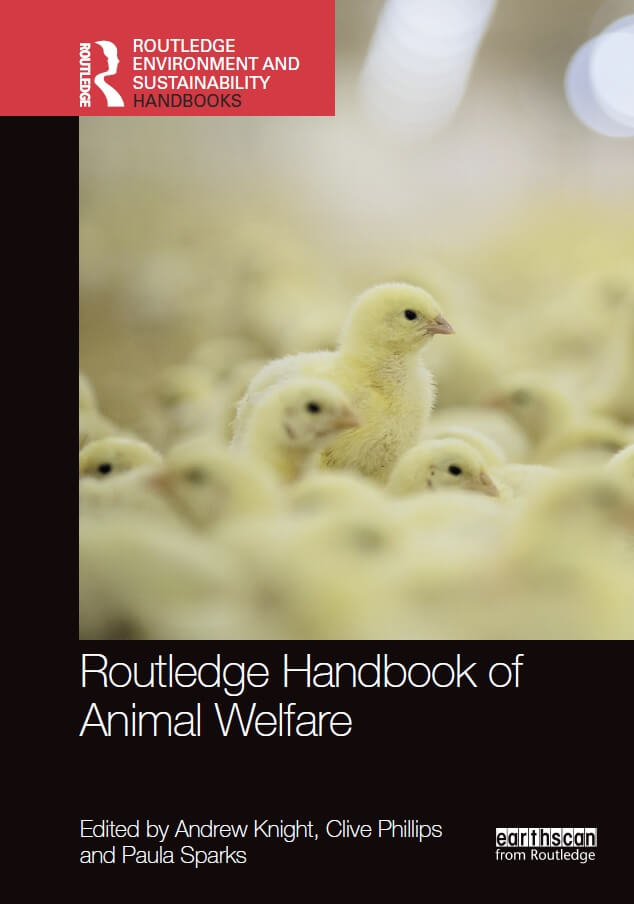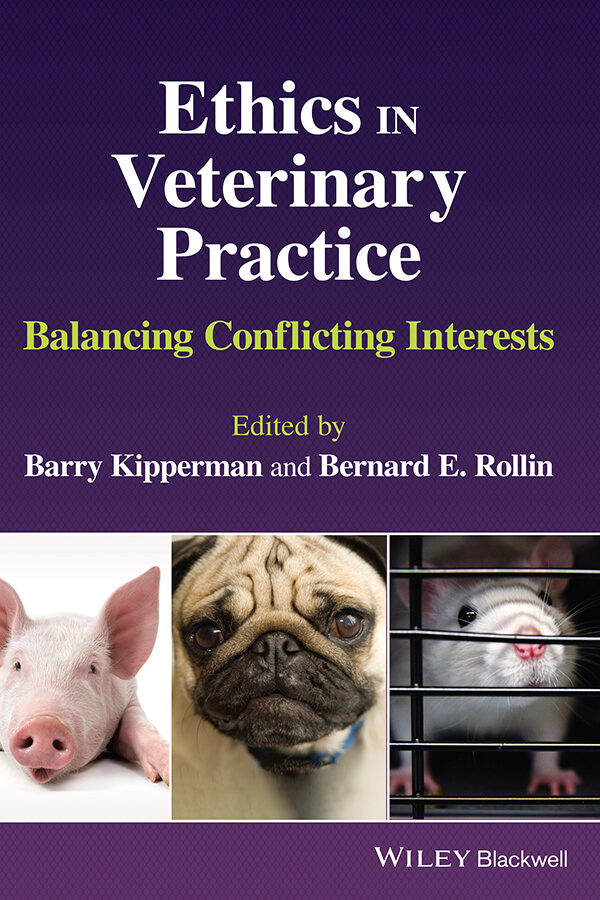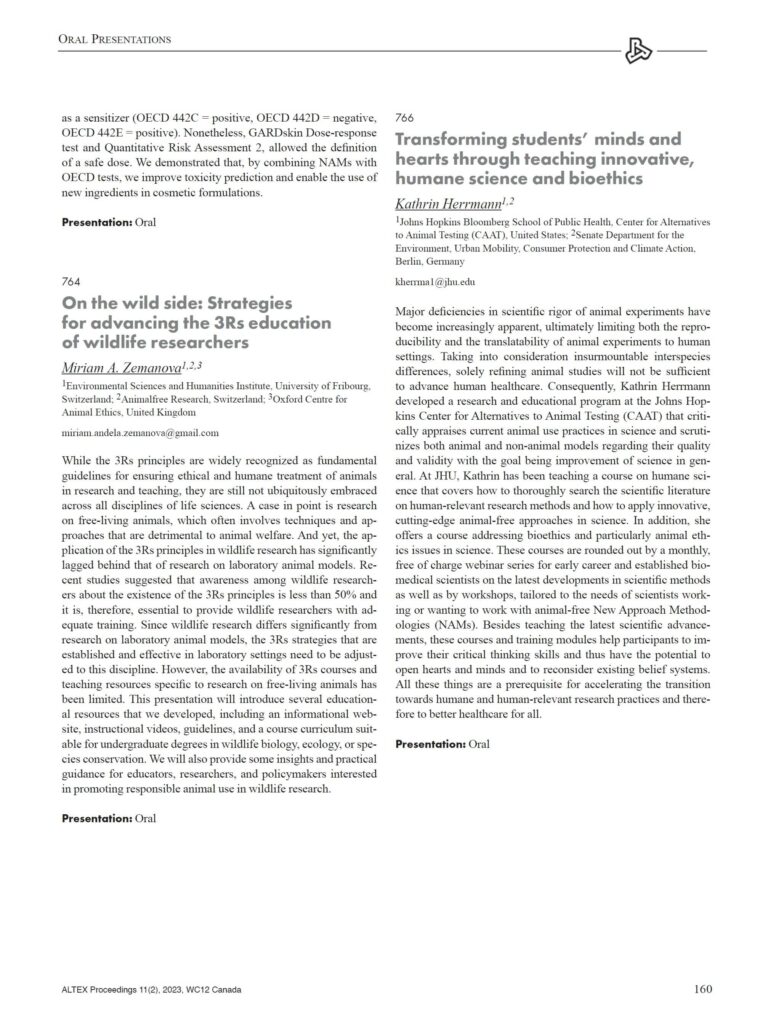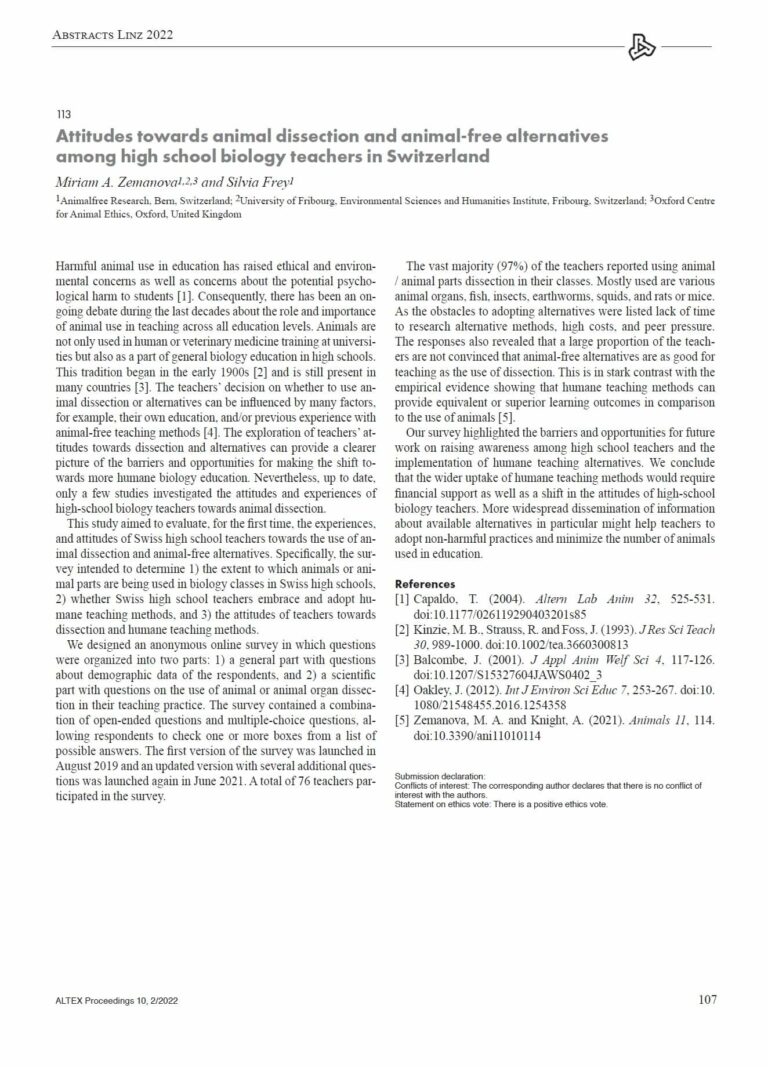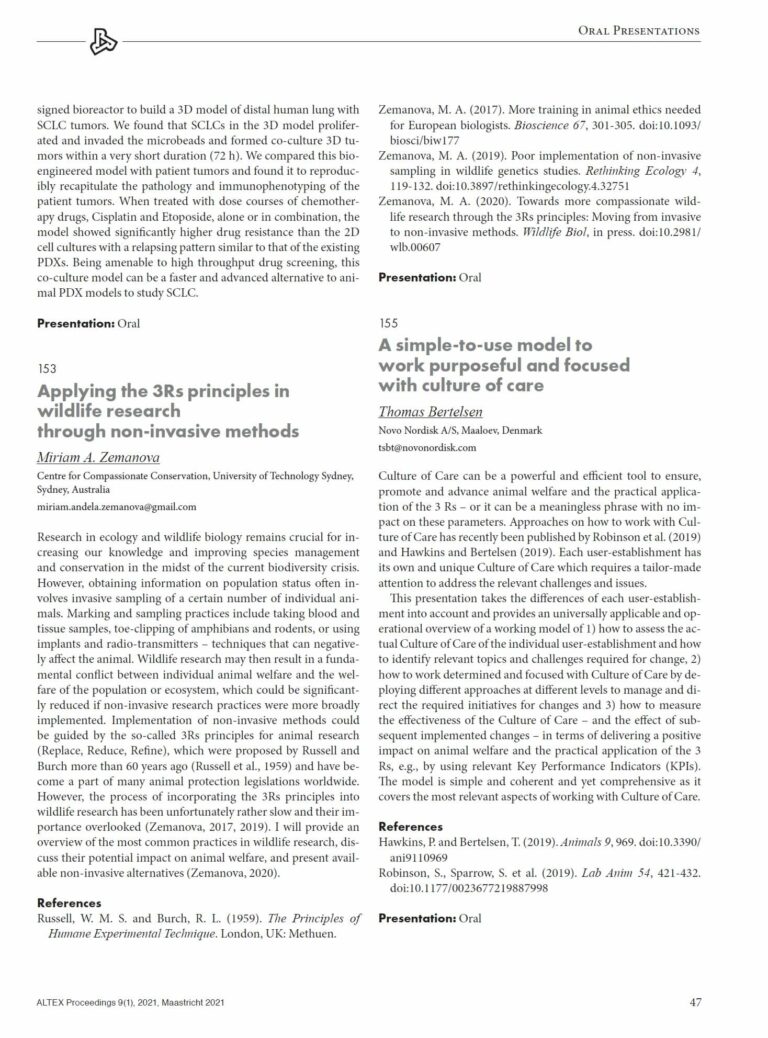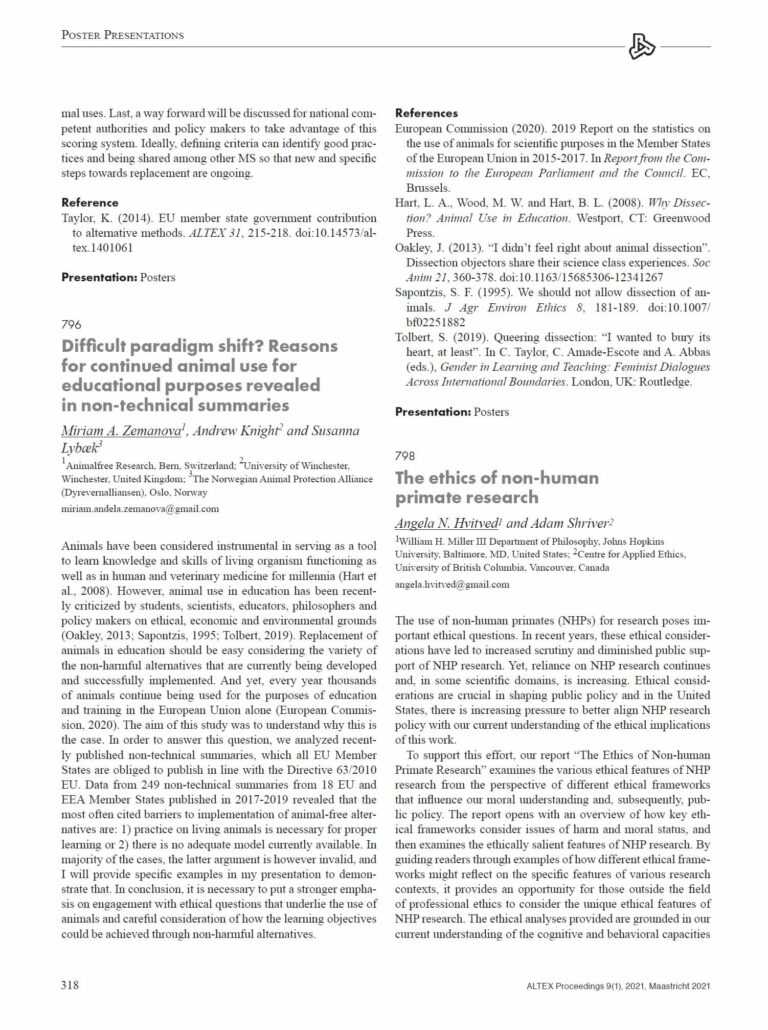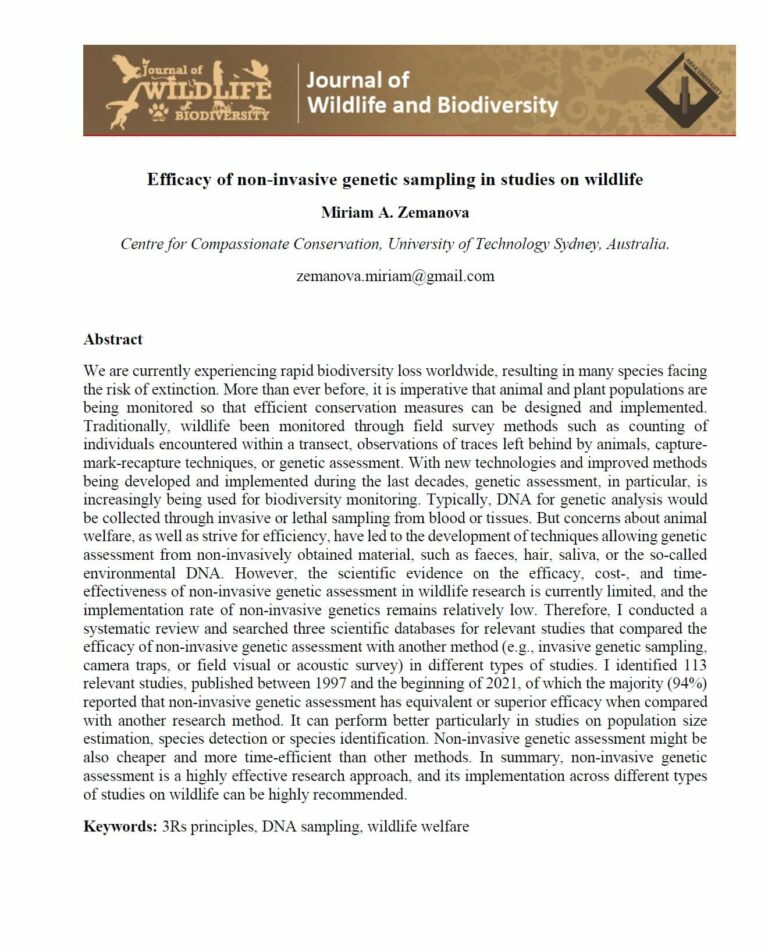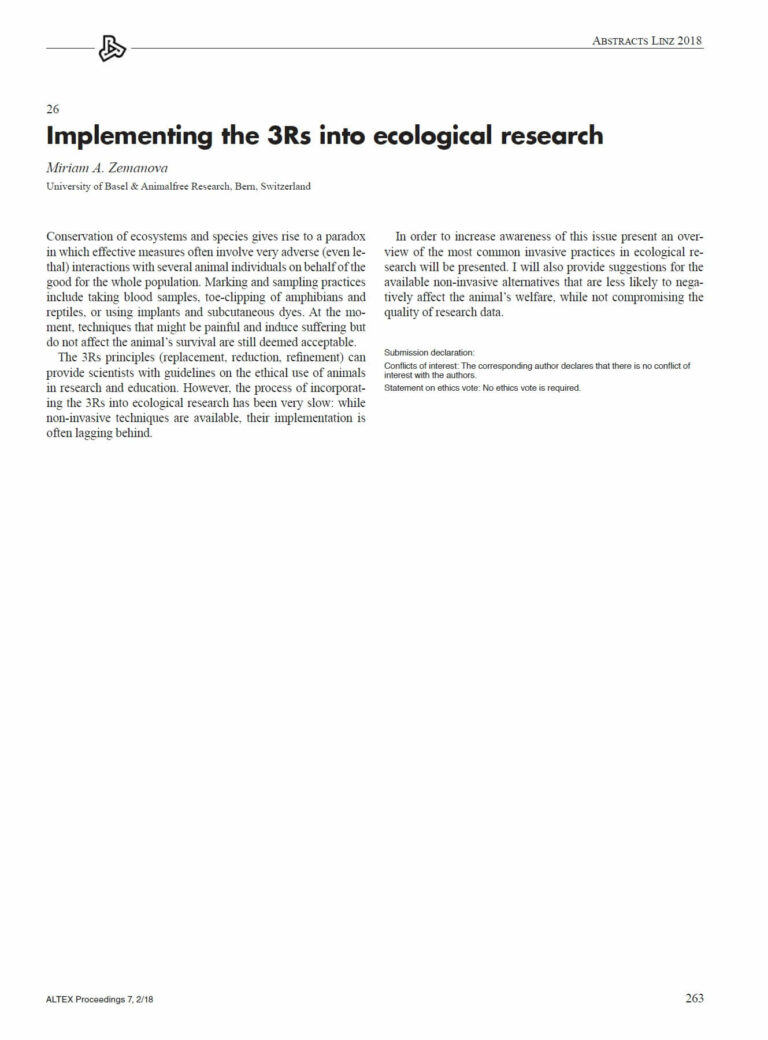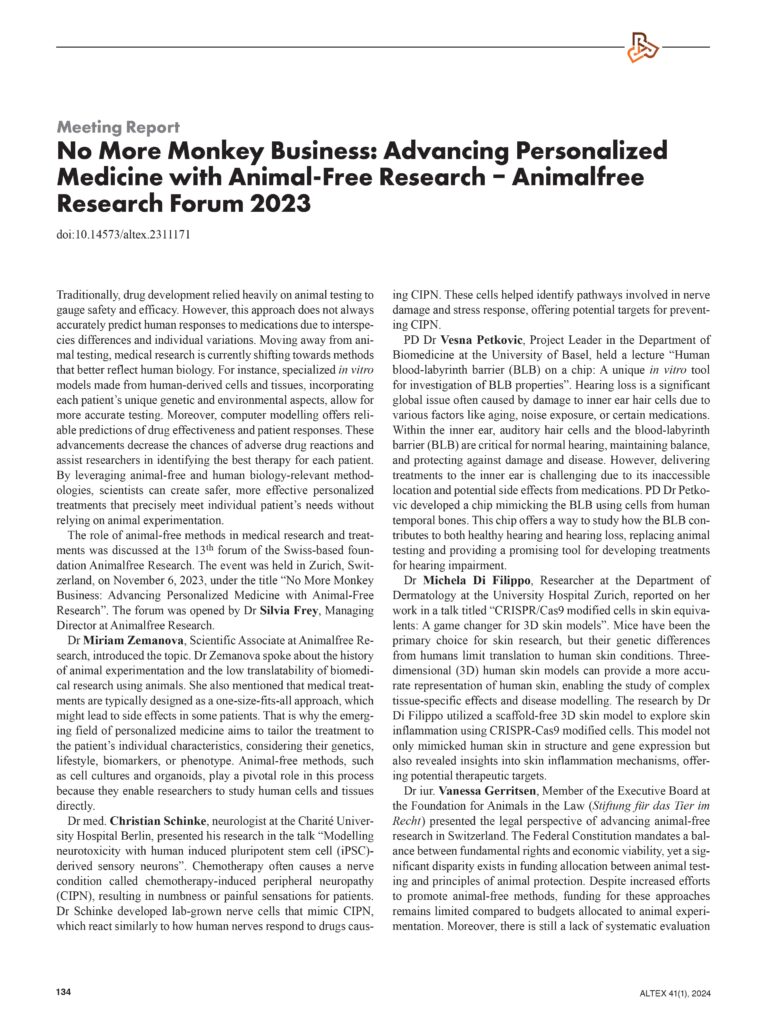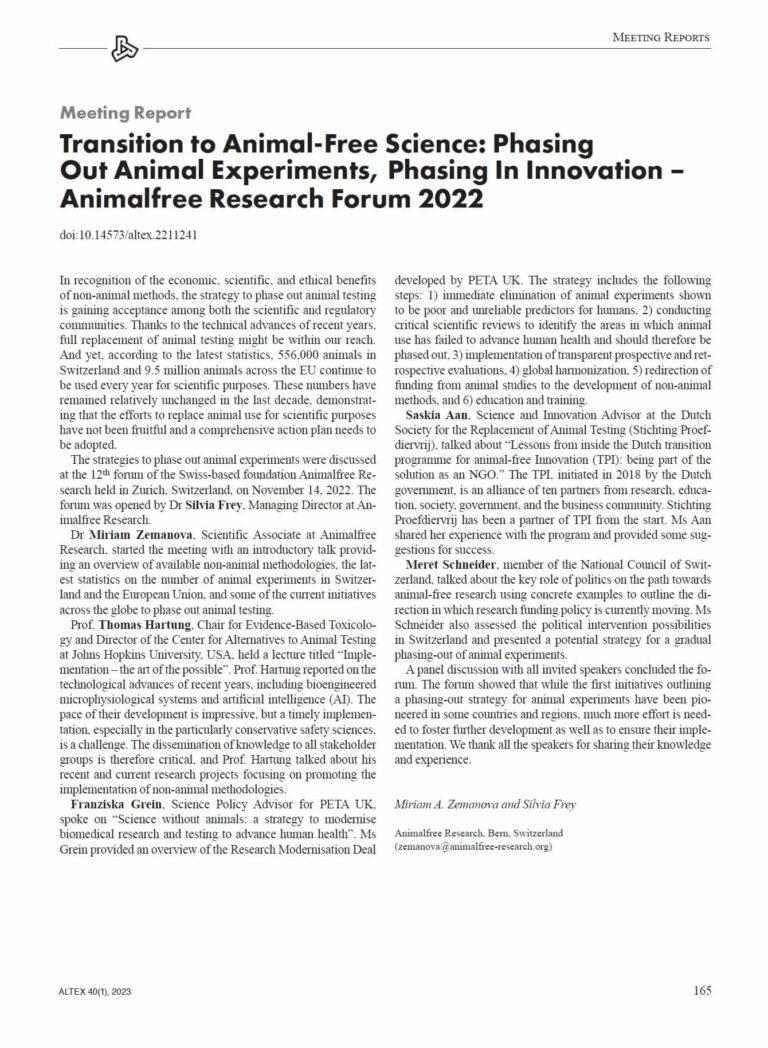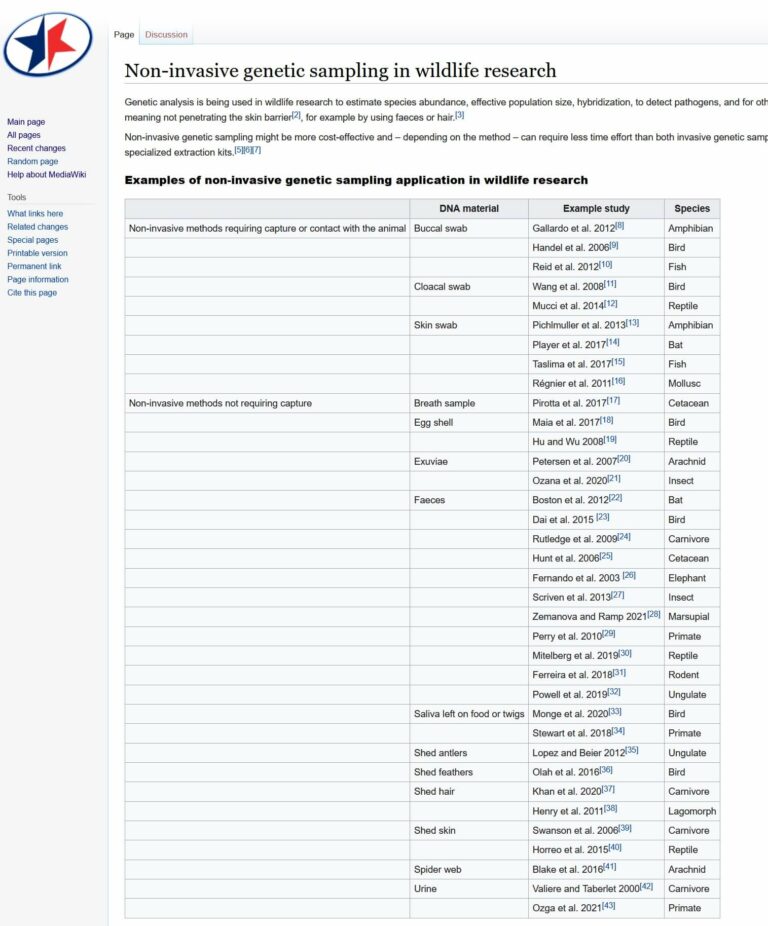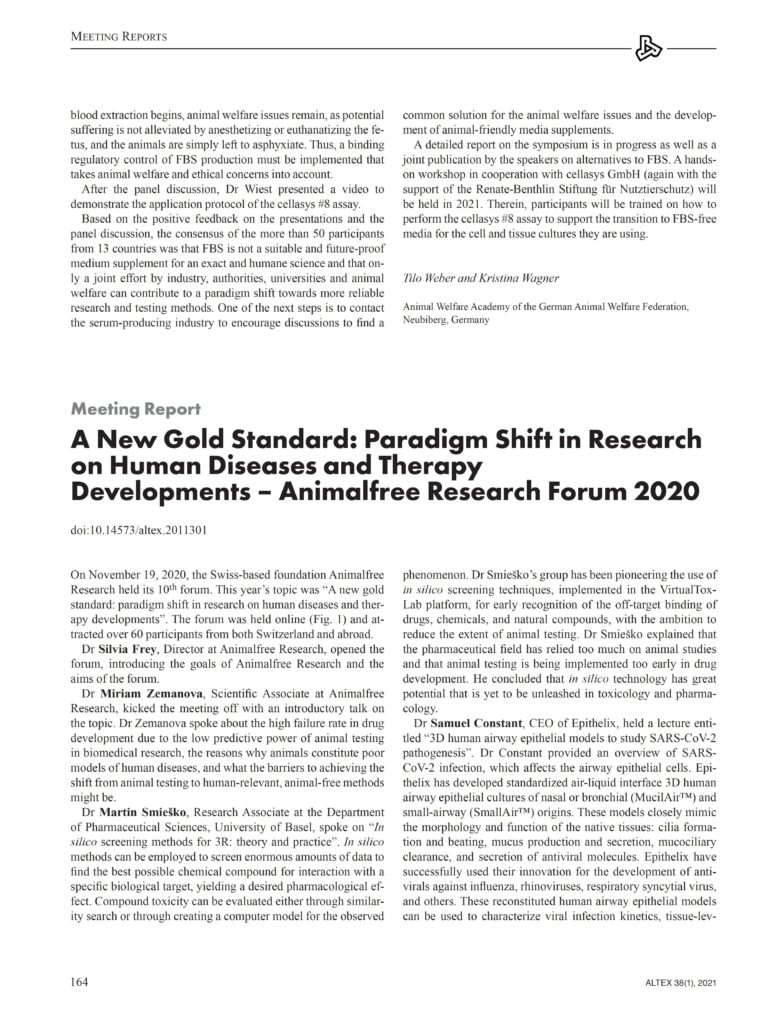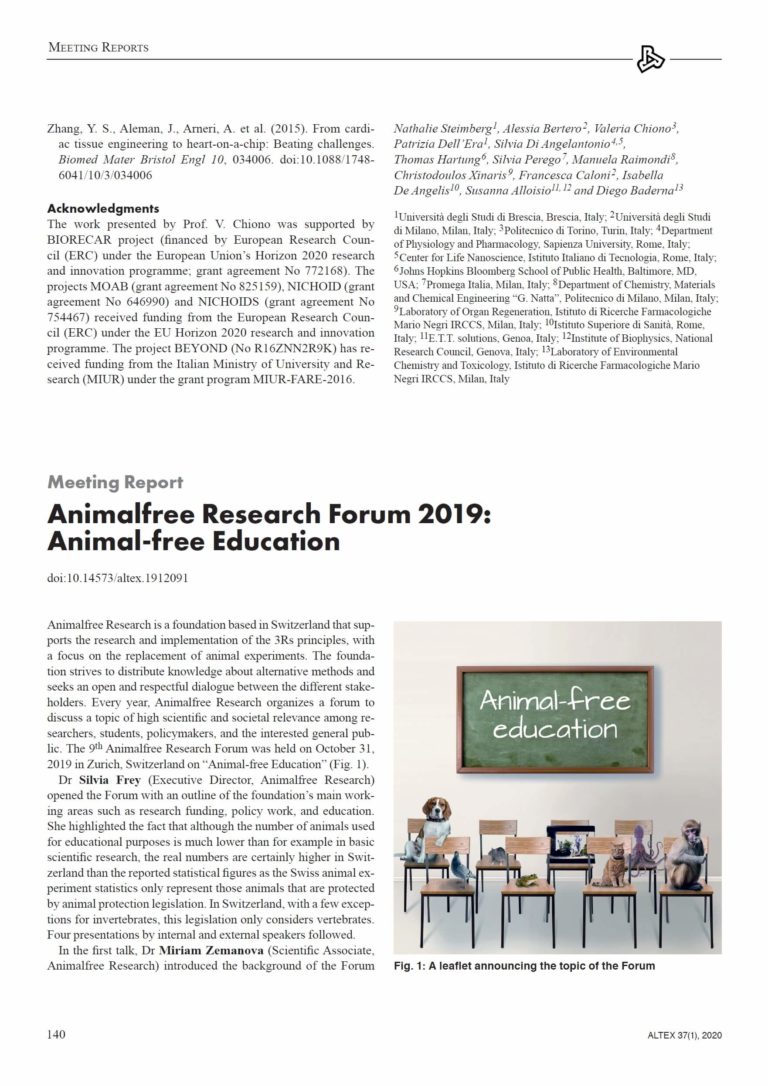PUBLICATIONS
Click on the image of the first page to get a pdf file of the publication.
PEER-REVIEWED ARTICLES
Zemanova M. A., Lázaro Martín R., Leenaars C. (2025): Animal welfare impact of toe-clipping in amphibians: a systematic review. Global Ecology and Conservation 59: e03582.
https://doi.org/10.1016/j.gecco.2025.e03582
Abstract
Amphibians, the animal class most threatened by extinction, are frequently studied in order to provide insights informing conservation efforts. This research regularly requires the capture and marking of individual animals or tissue sampling for genetic analyses. A common technique for both marking and collecting DNA from amphibians is toe-clipping, which involves cutting off a portion of one or more toes. Toe-clipping is relatively fast and cheap, but it might have a negative impact on animal welfare. However, results from studies investigating the impact of toe-clipping have been variable; while some studies have reported no effect on movement, survival, or stress levels, other studies showed the opposite. Therefore, the aim of this review was to evaluate all currently available evidence of the potential animal welfare impact of toe-clipping amphibians in a systematic manner. We searched the Web of Science, BioOne, and Agricola databases for relevant studies. Studies were incorporated into the review if they included original empirical data derived from experiments conducted on amphibians, evaluated the impact of toe clipping on welfare-related outcomes, and used either a suitable control group (no intervention or handling only), or compared outcomes in the same group before and after toe-clipping. Conference proceedings, reviews, non-peer-reviewed publications, informal reports and research employing co-interventions that might have affected the results were systematically excluded. The quality of the studies was evaluated with an augmented version of the SYstematic Review Centre for Laboratory animal Experimentation (SYRCLE)’s bias risk assessment tool for animal studies. In total, 14 relevant articles were identified and included in this review. The methodological design of these articles and their outcome measures showed considerable heterogeneity, and we observed an unclear or substantial risk of bias across all examined studies. Consequently, and in line with our protocol, no meta-analysis was performed and the evidence was narratively synthesised. Furthermore, none of the studies included a power or sample size calculation. Among 44 welfare-related outcomes assessed, we identified evidence indicating discomfort associated with toe-clipping, manifested as decreased jump distance immediately after toe-clipping, elevated corticosterone and decreased testosterone levels in urine, as well as long-term repercussions reflected in lower daily weight gain. Nevertheless, the existing evidence is too scarce and the methodological design of available studies too heterogeneous to reliably conclude that there is a welfare impact of toe-clipping amphibians. Since the quality of the current evidence remains questionable, there is a critical need for adequately powered, high-quality studies that report reliable and pertinent outcome measures to accurately determine the effects of this still popular marking and sampling method. Until more robust evidence is obtained, the impacts of toe-clipping on the welfare of amphibians used in research and the integrity of study results cannot be conclusively confirmed or dismissed. Following the precautionary principle as well as the legal requirements to implement the 3Rs (Replacement, Reduction, Refinement) in research, it may be preferable to use less invasive methods for marking and DNA collection purposes in amphibians in place of toe-clipping, whenever feasible, although case-by-case decisions for each study might be necessary.
Deckha M., Michel M., Azilagbetor D., Blattner C., Cajga Morales R., Davies G., Elger B., Faizee S., Fox M., Gerritsen V., Heuss A., Kämpfen L., Louis-Maerten E., Lüthi N., Milford A., Müller N. D., Persson K., Ritskes-Hoitinga M., Rothen-Rutishauser B., Rüttimann A., Stoykova K., Stucki S., Zemanova M. A. (2025): Accelerating animal replacement: how universities can lead – results of a one-day expert workshop in Zurich, Switzerland. ATLA 53: 106-118..
https://doi.org/10.1177/02611929251317434
Abstract
This report is a result of an interdisciplinary workshop held at the Collegium Helveticum in Zurich, Switzerland in February 2024, in which ideas for accelerating NAMs (New Approach Methodologies) in Swiss universities were shared and discussed. Due to regional differences in university organisation and funding structures, not all recommendations will be transferable to all regions worldwide. All participants were qualified to contribute to the discussion, due to their knowledge and experience of the Three Rs, in particular with regard to their implementation. The workshop participants believed that universities, which play a pioneering role in so many other areas, should also exploit their innovative potential in the field of animal-free research. The workshop uncovered four areas that would need to be addressed in order to achieve a significant change in university science culture and do more justice to the Three Rs, namely: language — innovative framing (pro-replacement framing in official university statements); knowledge transfer — communicating innovative findings in teaching (redirecting curriculum); change of values within science faculties; and structured implementation and well-coordinated planning of the transformation (establishment of a ‘transition unit’). Specific strategies for implementing these four areas are outlined. In addition, we discuss why the replacement of animal testing should be an essential goal for universities, why this goal has not yet been achieved, and why concerted efforts toward change are required.
Zemanova M. A. (2023): Crucial but neglected: limited availability of animal welfare courses in education of wildlife researchers. Animals 13: 2907.
https://doi.org/10.3390/ani13182907
Abstract
Animal welfare is a subject of increasing scientific and ethical concern in today’s society, crucial for the well-being of animals used in research and the integrity of scientific data. Equipping researchers in the life science disciplines with a science-based knowledge of animal welfare, behaviour, physiology, and health is, therefore, essential. Nevertheless, previous studies evaluating animal welfare education focused on veterinary, laboratory, or farm animal science. Consequently, the aim of this study was, for the very first time, to map the prevalence of animal welfare courses in the university education of ecologists, wildlife biologists, and conservation managers in Europe, Canada, the USA, Australia, and New Zealand. A comprehensive assessment of 1548 universities was conducted, resulting in the identification of 596 relevant programs at the bachelor’s and master’s levels. Analysis of the curricula revealed that only 1% of the programs offered a formal course on animal welfare, while 65% provided courses on animal behaviour, 59% on animal physiology, and 34% on animal health. However, the majority of these courses were listed as electives rather than mandatory components of the programs. These results underscore the need for universities to incorporate more formal and obligatory education in animal welfare in order to better prepare future ecologists, wildlife biologists, and conservation managers for the challenges of working with wildlife.
Zemanova M. A. (2023): Prevalence of conscientious objection policies to harmful animal use in education at medical and veterinary faculties in Europe. Trends in Higher Education 2: 332-339.
https://doi.org/10.3390/higheredu2020019
Abstract
The harmful use of animals in university education has been the topic of an ongoing debate for many years. With growing animal welfare concerns and the advancement of humane teaching methods, students have been asking for more ethical educational approaches. Consequently, many universities have established policies regarding conscientious objection to harmful animal use in education. These policies allow students and faculty members who object to the harmful use of animals on ethical or religious grounds to opt out of participation in such activities without facing negative consequences. Several universities worldwide have already implemented formal policies. However, no studies have yet investigated the extent of conscientious objection policies at universities within the EU and Switzerland. Therefore, the aim of this study was to assess—for the first time—the prevalence of conscientious objection policies at medical and veterinary faculties in Europe. The data showed that 94% of 348 faculties across 28 European countries still do not have a written and publicly available policy that allows students to use humane teaching methods. The future development and widespread implementation of such policies is an essential step toward creating an educational environment that is inclusive, respectful, and committed to ethical and innovative practices.
Zemanova M. A. (2022): Attitudes toward animal dissection and animal-free alternatives among high school biology teachers in Switzerland. Frontiers in Education 7: 892713. https://doi.org/10.3389/feduc.2022.892713
Abstract
Animal dissection has been a traditional teaching tool in biology for centuries. However, harmful animal use in education has raised ethical and environmental concerns in the last decades and led to an ongoing debate about the role and importance of animal dissection in teaching across all education levels. To understand the current status of dissection in secondary education and the attitudes toward humane teaching alternatives among the educators, I conducted a survey–for the first time–among high school biology teachers in Switzerland. The specific aims of this study were (i) to explore the extent of animal or animal parts dissection in high school biology classes, (ii) to understand the attitudes and experiences of high school biology teachers toward dissection and animal-free alternatives, and (iii) to gain some insight into the circumstances hindering a wider uptake of alternatives to animal dissection in high school education. In total, 76 teachers participated in the online survey. The vast majority (97%) of the participants reported using animal dissection in their classes. The responses also revealed that a large proportion of the teachers consider animal-free alternatives inferior teaching tools in comparison with dissection. As the obstacles to adopting alternatives were most often listed the lack of time to research other methods, high costs, and peer pressure. In conclusion, the wider uptake of humane teaching methods would require financial support as well as a shift in the attitudes of high school biology teachers.
Zemanova M. A., Ramp D. (2021): Genetic structure and gene flow in eastern grey kangaroos in an isolated conservation reserve. Diversity 13: 570. https://doi.org/10.3390/d13110570
Abstract
Dispersal is a key process for population persistence, particularly in fragmented landscapes. Connectivity between habitat fragments can be easily estimated by quantifying gene flow among subpopulations. However, the focus in ecological research has been on endangered species, typically excluding species that are not of current conservation concern. Consequently, our current understanding of the behaviour and persistence of many species is incomplete. A case in point is the eastern grey kangaroo (Macropus giganteus), an Australian herbivore that is subjected to considerable harvesting and population control efforts. In this study, we used non-invasive genetic sampling of eastern grey kangaroos within and outside of the Mourachan Conservation Property to assess functional connectivity. In total, we genotyped 232 samples collected from 17 locations at 20 microsatellite loci. The clustering algorithm indicated the presence of two clusters, with some overlap between the groups within and outside of the reserve. This genetic assessment should be repeated in 10–15 years to observe changes in population structure and gene flow over time, monitoring the potential impact of the planned exclusion fencing around the reserve.
Zemanova M. A. (2021): Non-invasive genetic assessment is an effective wildlife research tool when compared with other approaches. Genes 12: 1672. https://doi.org/10.3390/genes12111672
Abstract
Wildlife research has been indispensable for increasing our insight into ecosystem functioning as well as for designing effective conservation measures under the currently high rates of biodiversity loss. Genetic and genomic analyses might be able to yield the same information on, e.g., population size, health, or diet composition as other wildlife research methods, and even provide additional data that would not be possible to obtain by alternative means. Moreover, if DNA is collected non-invasively, this technique has only minimal or no impact on animal welfare. Nevertheless, the implementation rate of non-invasive genetic assessment in wildlife studies has been rather low. This might be caused by the perceived inefficiency of DNA material obtained non-invasively in comparison with DNA obtained from blood or tissues, or poorer performance in comparison with other approaches used in wildlife research. Therefore, the aim of this review was to evaluate the performance of non-invasive genetic assessment in comparison with other methods across different types of wildlife studies. Through a search of three scientific databases, 113 relevant studies were identified, published between the years 1997 and 2020. Overall, the majority of the studies (94%) reported equivalent or superior performance of non-invasive genetic assessment when compared with either invasive genetic sampling or another research method. It might be also cheaper and more time-efficient than other techniques. In conclusion, non-invasive genetic assessment is a highly effective research approach, whose efficacy and performance are likely to improve even further in the future with the development of optimized protocols.
Zemanova M. A. (2021): Making room for the 3Rs principles of responsible animal use in ecology: potential issues identified through a pilot survey. European Journal of Ecology 7: 18-39. https://doi.org/10.17161/eurojecol.v7i2.14683
Abstract
Research on animals is one of the most controversial ethical issues in our society. The concern for animal welfare has been increasing in recent years and it is therefore imperative that any potential harm and distress to animals used in research is minimized. This could be achieved through the implementation of the so-called 3Rs principles for animal research (Replace, Reduce, Refine), which are now anchored in many legislations worldwide. In this scientific forum article, I comment on how the 3Rs might be useful specifically for ecological research on wildlife. While the main benefit of the 3Rs principles is improved animal welfare, their implementation also provides opportunities for better science, saved costs, public support, and innovation. However, the awareness and implementation of the 3Rs, and attitudes about animal use in ecological research and education, have never been examined before. In order to close this gap, I conducted a pilot survey among ecologists working with wildlife. Even though the responses from 107 respondents from 23 countries are unlikely to represent the whole community of ecologists and should be, therefore, interpreted with caution, they provided several important insights. The responses from ecologists across different age classes and career stages revealed that lethal and invasive research methods might be prevalent when working with both invertebrate and vertebrate species, and that more than half of the respondents have never heard of the 3Rs principles for animal research. The reported lack of calculation of the minimum sample size and the widespread dissection classes as a part of education may also be of concern. Based on these findings, it is highly recommended to implement rigorous ethical and methodological standards for ecological practice and education and enforce the implementation of the 3Rs principles in wildlife research.
Zemanova M. A., Knight A., Lybaek S. (2021): Educational use of animals in Europe indicates reluctance to implement alternatives. ALTEX 38: 490-506. https://doi.org/10.14573/altex.2011111
Abstract
Animals have been considered an indispensable tool to teach about the functioning of living organisms, to obtain skills necessary for practicing human and veterinary medicine, as well as for acquiring skills for caring for and conducting experiments on animals in laboratories. However, the efficacy of this practice has been questioned in recent decades, and societal views have evolved to place a much stronger emphasis on animal welfare and ethics that needs to be reflected in our teaching and training practices. Currently, many alternatives to harmful animal use are available, and it is not clear why thousands of animals continue to be used every year for educational and training purposes. Therefore, this study aimed to identify reasons for the lack of uptake of non-harmful educational and training methods by analyzing recently published non-technical summaries in the EU and EEA Member States and to provide examples of alternatives for specific learning objectives. Results from non-technical summaries from 18 countries spanning the most recent years (2017-2019) revealed that the two main perceived reasons for continued animal use are: 1) the necessity to use a living animal for “proper” learning and 2) the lack of an adequate alternative. We argue that these reasons often do not reflect reality. In conclusion, we consider it is necessary to place a stronger emphasis on engagement with ethical questions that underlie the use of animals and careful consideration of how the learning objectives could be achieved through non-harmful alternatives.
Zemanova M. A. (2021): New online resource on the 3Rs principles of animal research for wildlife biologists, ecologists, and conservation managers. Conservation 1: 106-112.
https://doi.org/10.3390/conservation1020009
Abstract
The Earth’s biodiversity is in crisis. Without radical action to conserve habitats, the current rate of species extinction is predicted to accelerate even further. Efficient species conservation requires planning, management, and continuous biodiversity monitoring through wildlife research. Conservation biology was built on the utilitarian principle, where the well-being of species, populations, and ecosystems is given priority over the well-being of individual animals. However, this tenet has been increasingly under discussion and it has been argued that wildlife researchers need to safeguard the welfare of the individual animals traditionally subjected to invasive or lethal research procedures. The 3Rs principles of animal use (Replacement, Reduction, and Refinement) have become the cornerstone of ethical scientific conduct that could minimize the potential negative impact of research practices. One of the obvious strategies to implement the 3Rs in wildlife studies is to use non-invasive or non-lethal research methods. However, in contrast to toxicological or pharmacological research on laboratory animal models, up to now no 3Rs databases or online resources designed specifically for wildlife biologists, ecologists, and conservation managers have been available. To aid the implementation of the 3Rs principles into research on wildlife, I developed an online resource whose structure is outlined in this paper. The website contains a curated database of peer-reviewed articles that have implemented non-invasive or non-lethal research methods that could be used as a guideline for future studies.
Zemanova M. A., Knight A. (2021): The educational efficacy of humane teaching methods: a systematic review of the evidence. Animals 11: 114. https://doi.org/10.3390/ani11010114
Editor’s Choice
Abstract
Humane alternatives to harmful educational animal use include ethically-sourced cadavers, models, mannequins, mechanical simulators, videos, computer and virtual reality simulations, and supervised clinical and surgical experiences. In many life and health sciences courses, however, traditional animal use persists, often due to uncertainty about the educational efficacy of humane alternatives. The most recent comprehensive reviews assessing learning outcomes of humane teaching methods, in comparison to harmful animal use, were published more than 10 years ago. Therefore, we aimed to collate and analyse the combined evidence from recent and older studies about the efficacy of humane teaching methods. Using specific search terms, we systematically searched the Web of Science, SCOPUS, and EMBASE databases for relevant educational studies. We extracted information on publication years, the country in which the study was conducted, field, humane teaching methods, form of learning outcome assessment, and the learning outcome of the humane teaching methods, in comparison with harmful animal use. We found 50 relevant studies published from 1968–2020, primarily stemming from the USA, UK, and Canada. Humane teaching methods produced learning outcomes superior (30%), equivalent (60%), or inferior (10%) to those produced by traditional harmful animal use. In conclusion, a wide-spread implementation of humane teaching methods would not only preserve learning outcomes, but may in fact be beneficial for animals, students, educators, and institutions.
Wallach A. D., Batavia C., Nelson M. P., Bekoff M., Baker L., Ben-Ami D., Boronyak L., Cardilini A., Carmel Y., Celermajer D., Coghlan S., Dahdal Y., Gomez Y., Kaplan G., Keynan O., Khalilieh A., Kopnina H., Lynn W., Narayanan Y., Riley S., Santiago-Ávila F. J., Yanco E., Zemanova M. A., Ramp D. (2020): Recognizing animal personhood in compassionate conservation. Conservation Biology 34: 1097–1106. https://doi.org/10.1111/cobi.13494
Abstract
Compassionate conservation is based on the ethical position that actions taken to protect biodiversity should be guided by compassion for all sentient beings. Critics argue that there are 3 core reasons harming animals is acceptable in conservation programs: the primary purpose of conservation is biodiversity protection; conservation is already compassionate to animals; and conservation should prioritize compassion to humans. We used argument analysis to clarify the values and logics underlying the debate around compassionate conservation. We found that objections to compassionate conservation are expressions of human exceptionalism, the view that humans are of a categorically separate and higher moral status than all other species. In contrast, compassionate conservationists believe that conservation should expand its moral community by recognizing all sentient beings as persons. Personhood, in an ethical sense, implies the individual is owed respect and should not be treated merely as a means to other ends. On scientific and ethical grounds, there are good reasons to extend personhood to sentient animals, particularly in conservation. The moral exclusion or subordination of members of other species legitimates the ongoing manipulation and exploitation of the living worlds, the very reason conservation was needed in the first place. Embracing compassion can help dismantle human exceptionalism, recognize nonhuman personhood, and navigate a more expansive moral space.
Zemanova M. A. (2020): Towards more compassionate wildlife research through the 3Rs principles: moving from invasive to non-invasive methods. Wildlife Biology 2020: wlb.00607. https://doi.org/10.2981/wlb.00607
Top Cited Article 2020-2021
Abstract
Research in ecology and wildlife biology remains crucial for increasing our knowledge and improving species management and conservation in the midst of the current biodiversity crisis. However, obtaining information on population status often involves invasive sampling of a certain number of individual animals. Marking and sampling practices include taking blood and tissue samples, toe-clipping of amphibians and rodents, or using implants and radio-transmitters – techniques that can negatively affect the animal. Wildlife research may then result in a fundamental conflict between individual animal welfare and the welfare of the population or ecosystem, which could be significantly reduced if non-invasive research practices were more broadly implemented. Implementation of non-invasive methods could be guided by the so-called 3Rs principles for animal research (replace, reduce, refine), which were proposed by Russell and Burch 60 years ago and have become a part of many animal protection legislations worldwide. However, the process of incorporating the 3Rs principles into wildlife research has been unfortunately rather slow and their importance overlooked. In order to help alleviate this situation, here I provide an overview of the most common practices in wildlife research, discuss their potential impact on animal welfare, and present available non-invasive alternatives.
Zemanova M. A. (2019): Poor implementation of non-invasive sampling in wildlife genetics studies. Rethinking Ecology 4: 119-132. https://doi.org/10.3897/rethinkingecology.4.32751
Abstract
The Earth’s biodiversity is currently experiencing immense pressure from habitat loss, overexploitation, global climate change, and invasive species, which escalate the global extinction crisis. Comprehensive knowledge of the extent and impact of biodiversity loss is therefore critical for determining species vulnerability and prioritizing conservation goals. An integral part of wildlife conservation research and management is nowadays genetic sampling. Animal DNA has been traditionally obtained invasively, from blood or other tissues, however public concerns over animal welfare require that animals are affected as little as possible during research. One of the ways to minimize the impact on wildlife animal welfare is to use non-invasive genetic sampling. Even though non-invasive genetic sampling techniques have been developed for many animal species, it is not clear how often they are being implemented. Here, I present an overview of recently published articles on genetics in amphibians, birds, carnivores, molluscs and rodents, for which I examined whether they used a lethal, invasive or non-invasive DNA sampling technique. Disappointingly, only 22% of the identified relevant studies implemented the available non-invasive genetic sampling method. I conclude highlighting the need for better implementation of non-invasive DNA collection methods in wildlife research through raising awareness, increasing financial support, and introducing more stringent criteria for obtaining research permits.
Zemanova M. A., Broennimann O., Guisan A., Knop E., Heckel G. (2018): Slimy invasion: climatic niche and the current and future biogeography of Arion slugs invaders. Diversity and Distributions 24: 1627-1640. https://doi.org/10.1111/ddi.12789
Abstract
The current volume of global trade has led to an unprecedented rate of biological invasions, causing severe problems to native ecosystems. The knowledge of species introduction routes and areas suitable for establishment is therefore an important step in preventing future invasions. The situation can be further exacerbated by climate change, which might alter the amount of environmentally suitable areas for establishment of invasive species. Here, we focus on three Arion slug species recently introduced to North America and Australia with potentially significant impact—A. ater , A. rufus and A. vulgaris . We combined interception records, molecular analyses and species distribution modelling to assess their introduction history and to predict which regions are at highest risk of future invasions. We found extensive sharing of mitochondrial haplotypes among continents in all three species. In concordance with the genetic analyses, interception records suggest that slugs were introduced to the USA and Australia primarily from France, the Netherlands and the UK, but also from other locations in North America. The models predicted climatically suitable regions for the three Arion species in several areas across the globe for which management actions can be targeted. While the amount of regions with climatic conditions that would be suitable for slug establishment is predicted to slightly decrease under future scenarios, new suitable areas will also emerge. We therefore recommend that prevention efforts to limit new introductions should continue in order to protect vulnerable native ecosystems.
Zemanova M. A., Knop E., Heckel G. (2017): Introgressive replacement of natives by invading pest slugs. Scientific Reports 7: 14908. https://doi.org/10.1038/s41598-017-14619-y
Abstract
Hybridization with invasive species is one of the major threats to the phenotypic and genetic persistence of native organisms worldwide. Arion vulgaris (syn. lusitanicus) is a major agricultural pest slug that successfully invaded many European countries in recent decades, but its impact on closely related native species remains unclear. Here, we hypothesized that the regional decline of native A. rufus is connected with the spread of invasive A. vulgaris, and tested whether this can be linked to hybridization between the two species by analyzing 625 Arion sp. along altitudinal transects in three regions in Switzerland. In each region, we observed clear evidence of different degrees of genetic admixture, suggesting recurrent hybridization beyond the first generation. We found spatial differences in admixture patterns that might reflect distinct invasion histories among the regions. Our analyses provide a landscape level perspective for the genetic interactions between invasive and native animals during the invasion. We predict that without specific management action, A. vulgaris will further expand its range, which might lead to local extinction of A. rufus and other native slugs in the near future. Similar processes are likely occurring in other regions currently invaded by A. vulgaris.
Zemanova M. A., Perotto-Baldivieso H. L., Dickins E. L., Gill A. B., Leonard J. P., Wester D. B. (2017): Impact of deforestation on habitat connectivity thresholds for large carnivores in tropical forests. Ecological Processes 6: 21. https://doi.org/10.1186/s13717-017-0089-1
Highly Cited Paper Award for 2019
Abstract
Deforestation significantly impacts large carnivores that depend on large tracts of interconnected forest habitat and that are sensitive to human activities. Understanding the relationship between habitat use and spatial distribution of such species across human modified landscapes is critical when planning effective conservation strategies. This study assessed the presence of potential landscape connectivity thresholds resulting from habitat fragmentation associated with different deforestation patterns using a scale-based approach that links species-specific home ranges with the extent of anthropogenic activities. The objectives were (1) to quantify the spatial and temporal distribution of natural vegetation for five common deforestation patterns and (2) to evaluate the connectivity associated with these patterns and the existence of potential thresholds affecting jaguar dispersal. The Bolivian lowlands, located within jaguar conservation units, were analysed with landscape metrics to capture the spatial and temporal changes within deforested areas and to determine potential impact on jaguar connectivity and connectivity thresholds for dispersal. Our study highlights the importance of scale-based approaches for assessing current conservation challenges to protect large carnivores.
Zemanova M. A. (2017): More training in animal ethics needed for European biologists. BioScience 67: 301-305. https://doi.org/10.1093/biosci/biw177
Abstract
Research on basic animal biology and ecology is essential for increasing our knowledge and for improving species conservation. However, it often involves the suffering or killing of a certain number of animals, and such matters are rarely debated. Moreover, in providing education in ethics, biology seems to lag behind other disciplines of life sciences. Here, I first review several situations in biological research and species management in which animal ethics issues arise. Second, in order to determine the current status of the ethics education of undergraduate students in biological sciences in Europe, I report the results of the evaluation of curricula at 150 universities offering such programs. Surprisingly, merely 9% of the programs offered ethics as a mandatory and stand-alone course. I consider this a significant gap in biological education and advocate that biologists should receive proper training in animal ethics.
Zemanova M. A., Knop E., Heckel G. (2016): Phylogeographic past and invasive presence of Arion pest slugs in Europe. Molecular Ecology 25: 5747-5764. https://doi.org/10.1111/mec.13860
Abstract
Arion vulgaris (syn. A. lusitanicus ) is the most destructive pest slug in Europe. The species has been regarded a classic case of an ongoing biological invasion with negative economic and ecological impact in many European countries, but this status has recently been contested. In this study, we assessed mitochondrial and autosomal genetic diversity in populations of A. vulgaris across the entire distribution range in order to characterize its evolutionary history. Mitochondrial diversity in A. vulgaris was strongly reduced compared with the closely related and largely codistributed noninvasive species A. rufus and A. ater , indicating a very rapid spread of A. vulgaris through Europe. Autosomal diversity assessed in 632 individuals from 32 populations decreased towards eastern and northern Europe which is consistent with the reported expansion of the species towards these regions in the last decades. Demographic simulations supported very recent population founding events in most of the European range. The short periods between the first detection of A. vulgaris in different countries and only a very weak association of genetic structuring among populations with geographical distances suggest a human contribution in the ongoing expansion of the slug. We propose that this contribution may ultimately prevent the exact localization of the debated region of origin of A. vulgaris . However, the reclassification of A. vulgaris as noninvasive would be premature. Without counter measures, the Eastern and Northern European countries can expect to see this biological invasion continued in the future.
Desurmont G. A., Zemanova M. A., Turlings T. C. J. (2016): The gastropod menace: slugs on Brassica plants affect caterpillar survival through consumption and interference with parasitoid attraction. Journal of Chemical Ecology 42: 183–192. https://doi.org/10.1007/s10886-016-0682-2
Abstract
Terrestrial molluscs and insect herbivores play a major role as plant consumers in a number of ecosystems, but their direct and indirect interactions have hardly been explored. The omnivorous nature of slugs makes them potential disrupters of predator-prey relationships, as a direct threat to small insects and through indirect, plant-mediated effects. Here, we examined the effects of the presence of two species of slugs, Arion rufus (native) and A. vulgaris (invasive) on the survivorship of young Pieris brassicae caterpillars when feeding on Brassica rapa plants, and on plant attractiveness to the main natural enemy of P. brassicae, the parasitoid Cotesia glomerata. In two separate predation experiments, caterpillar mortality was significantly higher on plants co-infested with A. rufus or A. vulgaris. Moreover, caterpillar mortality correlated positively with slug mass and leaf consumption by A. vulgaris. At the third trophic level, plants infested with slugs and plants co-infested with slugs and caterpillars were far less attractive to parasitoids than plants damaged by caterpillars only, independently of slug species. Chemical analyses confirmed that volatile emissions, which provide foraging cues for parasitoids, were strongly reduced in co-infested plants. Our study shows that the presence of slugs has the potential to affect insect populations, directly via consumptive effects, and indirectly via changes in plant volatiles that result in a reduced attraction of natural enemies. The fitness cost for P. brassicae imposed by increased mortality in presence of slugs may be counterbalanced by the benefit of escaping its parasitoids.
Zemanova M. A., Knop E., Heckel G. (2015): Development and characterization of novel microsatellite markers for the Arion species. Conservation Genetics Resources 7: 501-503. https://doi.org/10.1007/s12686-014-0406-2
Abstract
Seventeen polymorphic microsatellite markers were isolated and characterized in Arion vulgaris/lusitanicus, which belongs to the worst European slug pests with serious economic and ecological impact. These markers were tested on 23 individuals collected in a population in Switzerland. Numbers of alleles ranged from 2 to 14 per locus, observed and expected heterozygosities ranged from 0.174 to 0.87, and from 0.162 to 0.903, respectively. These loci were also successfully amplified and were polymorphic in the closely related species A. rufus and A. ater. These loci represent the first highly polymorphic nuclear markers described for A. vulgaris and pave the way for population genetics and molecular ecology research of the important Arion pest slugs.
BOOK CHAPTERS
Zemanova M. A. (2022): Non-Domesticated Terrestrial Species. In Knight A., Phillips C., Sparks P. (Eds.), Routledge Handbook of Animal Welfare (1st ed., pp. 271-281). London, UK, Routledge. https://doi.org/10.4324/9781003182351
Abstract
Animal welfare science is a well-established discipline that has traditionally focused on farm, companion, or laboratory animals. In contrast, consideration of wildlife welfare has been rather neglected and there still remain many unknowns. Nevertheless, the interest in the welfare of non-domesticated terrestrial species has grown in recent years, reflecting our increased understanding of the influence that humans have on wildlife through both intentional and unintentional activities. This chapter begins by discussing the welfare of animals living in the wild and follows by examining the potential animal welfare issues emerging in wildlife rehabilitation and reintroduction programs, through the use of invasive sampling or marking methods in wildlife research, and within the exotic pet trade.
Knight A., Zemanova M. A. (2022): Animal Use in Veterinary Education. In Kipperman B., Rollin B. E. (Eds.), Ethics in Veterinary Practice: Balancing Conflicting Interests (1st ed., pp. 369-402). New Jersey, USA, John Wiley & Sons, Inc. https://doi.org/10.1002/9781119791256.ch18
Abstract
The adequate preparation of students for clinical practice is a major challenge within veterinary education. To teach clinical and surgical skills and scientific concepts, animals have often been used as teaching tools, and are subjected to invasive procedures, which sometimes result in death. Animals are also used in non-harmful ways, such as when student-owned dogs are used to teach clinical examination skills. Such uses are not generally controversial. In contrast, the harmful use of animals within veterinary education is ethically contentious. This chapter focuses on such animal use, reviewing both the animal and human impacts of such use, the efficacy and benefits of alternative teaching methods, applicable legislation, and the positions of veterinary professional associations. The interests of both animals and students who do not wish to harm them are protected by animal welfare and human rights legislation in various countries.
CONFERENCE PROCEEDINGS
Zemanova M. A. (2023): On the wild side: Strategies for advancing the 3Rs education of wildlife researchers. ALTEX Proceedings 11: 160. https://doi.org/10.58847/ap.2302
12th World Congress on Alternatives and Animal Use in the Life Sciences
Zemanova M. A., Frey S. (2022): Attitudes towards animal dissection and animal-free alternatives among high school biology teachers in Switzerland. ALTEX Proceedings 10: 107. https://doi.org/10.58847/ap.2202
23rd Congress of the European Society for Alternatives to Animal Testing
Zemanova M. A. (2021): Applying the 3Rs principles in wildlife research through non-invasive methods. ALTEX Proceedings 9: 47. https://doi.org/10.58847/ap.2101
11th World Congress on Alternatives and Animal Use in the Life Sciences
Zemanova M. A., Knight A., Lybaek S. (2021): Difficult paradigm shift? Reasons for continued animal use for educational purposes revealed in non-technical summaries. ALTEX Proceedings 9: 318. https://doi.org/10.58847/ap.2101
11th World Congress on Alternatives and Animal Use in the Life Sciences
Zemanova M. A. (2021): Efficacy of non-invasive genetic sampling in studies on wildlife. Journal of Wildlife and Biodiversity ICWEB 2021: 14. https://www.wildlife-biodiversity.com/index.php/jwb/issue/view/16/4
International Conference on Wildlife Ecology and Biodiversity Conservation
Zemanova M. A., Frey S. (2019): Implementation status of non-invasive methods in wildlife genetic sampling. ALTEX Proceedings 8: 224. https://doi.org/10.58847/ap.1901
22nd Congress of the European Society for Alternatives to Animal Testing
Zemanova M. A. (2018): Implementing the 3Rs into ecological research. ALTEX Proceedings 7: 263. https://doi.org/10.58847/ap.1802
21st Congress of the European Society for Alternatives to Animal Testing
OTHER PUBLICATIONS
Zemanova M. A. (2024): Tierethik in der Wildtierforschung. TIERethik 16: 25-44. https://doi.org/10.58848/tierethik.2024.2.25
Abstract
Wildlife research is key to preserving biodiversity and protecting endangered species. However, it poses some ethical challenges, especially concerning the welfare of individual animals. This article examines these ethical challenges and presents solutions for animal ethics in wildlife research. Upon analysis of traditional research methods, the need to harmonise animal welfare and species protection becomes apparent. Particular attention is paid to the need to consistently implement the 3R principles, to develop minimally invasive research methods, and the importance of comprehensive education in ethics and animal welfare for wildlife researchers. This article is an appeal to researchers to continuously reflect and question and improve their research methods. The goal is to create a balance between species protection and the well-being of individual animals. Ethical considerations should not only be discussed, but actively integrated into research practice.
Invited contribution to the special issue “Animal-friendly nature conservation” in the journal TIERethik, written in German.
Zemanova M. A., Frey S. (2024): No more monkey business: Advancing personalized medicine with animal-free research – Animalfree Research Forum 2023 (Meeting Report). ALTEX 41: 134-135. https://doi.org/10.14573/altex.2311171
Meeting Report
Zemanova M. A., Frey S. (2023): Transition to animal-free science: Phasing out animal experiments, phasing in innovation – Animalfree Research Forum 2022 (Meeting Report). ALTEX 40: 165. https://doi.org/10.14573/altex.2211241
Meeting Report
Zemanova M. A. (2022): Non-invasive genetic sampling in wildlife research. Refinement Wiki. https://wiki.norecopa.no/index.php/Non-invasive_genetic_sampling_in_wildlife_research
Contribution to the Norecopa’s Refinement Wiki
Zemanova M. A., Frey S. (2022): No More Secrets: Enhancing Transparency in Animal Research – Animalfree Research Forum 2021 (Meeting Report). ALTEX 39: 154. https://doi.org/10.14573/altex.2111291
Meeting Report
Zemanova M. A., Frey S. (2021): A New Gold Standard: Paradigm Shift in Research on Human Diseases and Therapy Developments – Animalfree Research Forum 2020. ALTEX 38: 164-165. https://doi.org/10.14573/altex.2011301
Meeting Report
Zemanova M. A., Frey S. (2020): Meeting Report – Animalfree Research Forum 2019: Animal-free Education. ALTEX 37: 140-142. https://doi.org/10.14573/altex.1912091
Meeting Report
